Electric Charges and Fields
Class 12th Physics Chapter Important Questions
Class 12 Physics Chapter 1 Important Questions Electric Charges and Fields
Very Short Answer
Question 1.
What is the value of the angle between the vectors \(\vec{p}\)
and \(\vec{E}\) for which the potential energy of an electric dipole of dipole
moment \(\vec{p}\), kept in an external electric field \(\vec{E}\), has maximum
value.
Answer:
P.E. = –pEcos θ
P.E. is maximum when cos θ = – 1,
i.e.
θ = 180°
Question 2.
Define electric field intensity at a point.
Answer:
Electric field intensity at a point is defined as the force experienced by a
unit test charge placed at that point. Mathematically
we have
Question 3.
Two equal point charges separated by 1 m distance experience
force of 8 N. What will be the force experienced by them, if they are held in
water, at the same distance? (Given: Kwater = 80)
Answer:
The force in water is given by
Fw = \(\frac{F_{\text
{air }}}{K}=\frac{8}{80}\) = 0.1 N
Question 3 a.
Which orientation of an electric dipole in a uniform electric
field would correspond to stable equilibrium ? (All India 2008)
Answer:
When dipole moment vector is parallel to electric field vector
\(\overrightarrow{\mathrm{P}} \| \overrightarrow{\mathrm{E}}\)
Question 4.
If the radius of the Gaussian surface enclosing a charge is
halved, how does the electric flux through the Gaussian surface change ?
Answer:
Electic flux ϕE is given by
\(\phi_{\mathrm{E}}=\oint
\overrightarrow{\mathrm{E}} \cdot d
\vec{s}=\frac{\mathrm{Q}}{\varepsilon_{0}}\)
…. where [Q is total charge
inside the closed surface
∴ On changing the radius of sphere, the electric
flux through the Gaussian surface remains same.
Question 5.
Define the term electric dipole moment of a dipole. State its
S.I. unit
Answer:
τ = OE sin θ
If E = 1 unit, θ = 90°, then τ = P
Dipole moment may be defined as the torque acting on an electric dipole, placed
perpendicular to a uniform electric dipole, placed perpendicular to a uniform
electric field of unit strength.
or Strength of electric dipole is called
dipole moment.
\(|\overrightarrow{\mathrm{P}}|=q|2 a|\)
∴ SI unit is
Cm.
Question 6.
In which orientation, a dipole placed in a uniform electric
field is in
- stable,
- unstable equilibrium ? (Delhi 2010)
Answer:
- For stable equilibrium, a dipole is placed parallel to the electric field.
- For unstable equilibrium, a dipole is placed antiparallel to the electric field.
Question 7.
Figure shows three point charges, +2q, -q and + 3q. Two
charges +2q and -q are enclosed within a surface ‘S’. What is the electric flux
due to this configuration through the surface ‘S’ (Delhi 2010)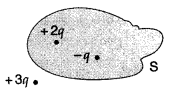
Answer:
\(\text { Electric flux }=\oint_{\mathrm{S}}
\overrightarrow{\mathrm{E}} \cdot \overrightarrow{d \mathrm{S}}\)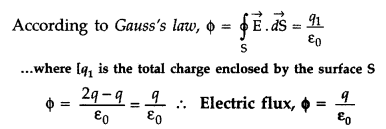
Question 8.
A charge ‘q’ is placed at the center of a cube of side l. What
is the electric flux passing through each face of the cube?
Answer:
Φ = q/6ε0
Question 9.
Why do the electric field lines not form closed loops?
Answer:
It is due to the conservative nature of the electric
field.
Question 10.
Two equal balls having equal positive charge ‘q’ coulomb are
suspended by two insulating strings of equal length. What would be the effect on
the force when a plastic sheet is inserted between the two?
Answer:
It decreases because force ∝= \(\frac{1}{k}\) and k > 1.
Question 11.
What is the electric flux through a cube of side l cm which
encloses an electric dipole?
Answer:
Zero
Question 12.
Why are electric field lines perpendicular at a point on an
equipotential surface of a conductor?
Answer:
So that no
net force acts on the charge at the equipotential surface and it remains
stationary.
Question 13.
What is the amount of work done in moving a point charge Q.
around a circular arc of radius ‘r’ at the centre of which another point charge
‘q’ is located?
Answer:
Zero.
Question 14.
How does the electric flux due to a point charge enclosed by
a spherical Gaussian surface get affected when its radius is increased?
Answer:
No change, as flux does not depend upon the size of
the Gaussian surface.
Question 15.
Name the physical quantity whose S.I. unit is JC-1.
Is it a scalar or a vector quantity? (All India 2010)
Answer:
- Physical quantity whose S.I. unit is JC-1 is Electric potential.
- It is a Scalar quantity.
Question 16.
Define electric dipole moment. Write its S.I. unit. (All India
2011)
Answer:
Electric dipole moment of an electric dipole is defined as
the product of the magnitude of either charge and dipole length.
S.I. unit of dipole (\(\vec{p}\)) is coulomb metre (Cm).
Question 17.
Why should electrostatic field be zero inside a conductor?
(Delhi 2012)
Answer:
Electrostatic field inside a conductor should be zero
because of the absence of charge. As in a static condition, charge remains only
on the surface.
Question 18.
Why must electrostatic field be normal to the surface at every
point of a charged conductor? (Delhi 2012)
Answer:
So that tangent on
charged conductor gives the direction of the electric field at that point.
Question 19.
A charge ‘q’ is placed at the centre of a cube of side l.
What is the electric flux passing through each face of the cube? (All India
2012)
Answer:
Electric flux through each phase of the cube![]()
Question 20.
A charge ‘q’ is placed at the centre of a cube of side l.
What is the electric flux passing through two opposite faces of the cube? (All
India)
Answer:
\(\phi_{\mathrm{E}}=\frac{q}{3 \varepsilon_{0}}\)
Question 21.
Depict the direction of the magnetic field lines due to a
circular current carrying loop. (Comptt. Delhi 2012)
Answer:
Direction of
the magnetic field lines is given by right hand thumb rule.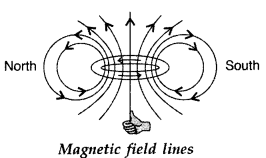
Question 22.
What is the direction of the electric field at the surface of
a charged conductor having charge density σ < 0? (Comptt. Delhi 2012)
Answer:
The direction of electric field is normal and inward to the
surface.
Question 23.
Why do the electric field lines not form closed loops?
Answer:
Electric field lines do not form closed
loops because the direction of an electric field is from positive to negative
charge. So one can regard a line of force starting from a positive charge and
ending on a negative charge. This indicates that electric field lines do not
form closed loops.
Question 24.
Is the electric field due to a charge configuration with
total charge zero, necessarily zero? Justify. (Comptt. All India 2012)
Answer:
No, it is not necessarily zero. If the electric field due to a charge
configuration with total charge is zero because the electric field due to an
electric dipole is non-zero.
Question 25.
Two charges of magnitudes – 2Q and + Q are located at points
(a, 0) and (4a,0) respectively. What is the electric flux due to these charges
through a sphere of radius ‘3a’ with its centre at the origin? (All India
2013)
Answer:![]()
Question 26.
Two charges of magnitudes -3Q and + 2Q are located at points
(a, 0) and (4a, 0) respectively. What is the electric flux due to these charges
through a sphere of radius ‘5a’ with its centre at the origin?
Answer: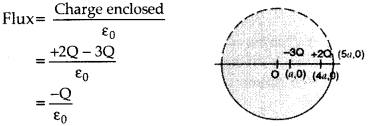
Question 27.
Write the expression for the work done on an electric dipole
of dipole moment p in turning it from its position of stable equilibrium to a
position of unstable equilibrium in a uniform electric
field E. (Comptt.
Delhi 2013)
Answer:
Torque, acting on the dipole is, τ = pE sin θ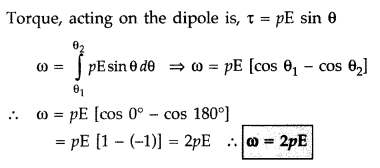
Question 28.
Why do the electrostatic field lines not form closed loops?
(All India 2014)
Answer:
Electric field lines do not form closed loops
because the direction of an electric field is from positive to negative charge.
So one can regard a line of force starting from a positive charge and ending on
a negative charge. This indicates that electric field . lines do not form closed
loops.
Question 29.
Draw the pattern of electric field lines, when a point charge
–Q is kept near an uncharged conducting plate.
Answer:
The pattern is as shown.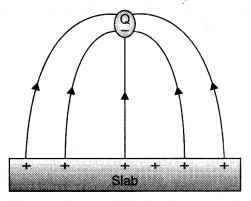
Question 30.
Draw a plot showing the variation of the electric field with
distance from the center of a solid conducting sphere of radius R, having a
charge + Q on its surface.
Answer:
The plot is as
shown.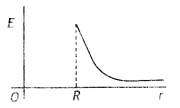
Question 31.
Draw a graph to show the variation of E with perpendicular
distance r from the line of charge (CBSE Delhi 2018)
A
Answer:
E =
\(\frac{\lambda}{2 \pi \varepsilon_{0} r}\)
E ∝ \(\frac{1}{r}\)
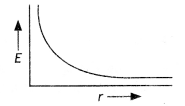
The graph between E and r is as shown.
Question 32.
Define the term ‘electric flux’. Write its S.I. unit.
Answer:
Electric flux: It is the measure of the number of
electric field lines crossing a given area normally.
Mathematically the electric flux passing through an area \(\vec{dS}\) is
given by
dΦ = \(\vec{E}\) . \(\vec{dS}\)
SI unit of electric flux is Nm2C-1 or Vm.
Question 33.
Why can the interior of a conductor have no excess charge in
the static situation? (CBSE Ai 2019)
Answer:
Since the electric field
inside the conductor is zero, electric flux through the closed surface is also
zero. Hence by Gauss’s law, there is no net charge enclosed by the closed
surface.
Question 34.
Two field lines never cross each other. Why?
Answer:
It
is because at the point of intersection two perpendiculars can be drawn. Thus
there will be two directions of the electric field at that point which is not
possible.
Question 35.
In an electric field, an electron is kept freely. If the
electron is replaced by a proton, what will be the force experienced by the
proton?
Answer:
The magnitude of force will be the same but the direction
will be reversed.
Question 36.
Why do the electric field lines never cross each other? (All
India)
Answer:
The electric lines of force give the direction of the
electric field. In case, two lines of force intersect, there will be two
directions of the electric field at the point of intersection, which is not
possible.
Question 37.
distance ‘d’ apart as shown in the figure. The electric field intensity is zero
at a point ’P’ on the line joining them as shown. Write two conclusions that you
can draw from this. (Comptt. Delhi 2014)
Answer:
- Two point charges ‘ q1‘ and ‘ q2 should be of opposite nature.
- Magnitude of charge ql must be greater than that of charge q2.
Question 38. What is the electric flux through a cube of side 1 cm which
encloses an electric dipole? (Delhi 2015)
Answer:
Zero because the net
charge of an electric dipole (+ q and – q) is zero.
Question 39.
Why are electric field lines perpendicular at a point on an
equipotential surface of a conductor? (Comptt. All India 2015)
Answer:
If
the electric field lines were not normal to the equipotential surface, it would
have a non-zero component along the surface. To move a unit test charge against
the direction of the component of the field, work would have to be done which
means this surface cannot be equipotential surface.
Hence, electric field
lines are perpendicular at a point on an equipotential surface of a
conductor.
Question 40.
Is the potential difference VA – VB positive, negative or
zero? (Delhi 2016)
Answer:
The potential difference is positive.
Question 41.
How does the electric flux due to a point charge enclosed by
a spherical Gaussian surface get affected when its radius is increased? (Delhi
2016)
Answer:
The electric flux due to a point charge enclosed by a
spherical gaussian surface remains ‘unaffected’ when its radius is
increased.
Question 42.
Show on a plot the nature of variation of the
- Electric field (E) and
- potential (V), of a (small) electric dipole with the distance (r) of the field point from the centre of the dipole. (Comptt. Outside Delhi 2016)
Answer: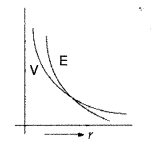
Question 43.
Does the charge given to a metallic sphere depend on whether
it is hollow or solid? Give reason for your answer. (Delhi 2017)
Answer:
No, it does not, because the charge resides only on the surface of the
conductor.
Question 44.
Draw a plot showing variation of electric field with distance
from the centre of a solid conducting sphere of radius R, having a charge of +Q
on its surface. (Comptt. Delhi 2017)
Answer:
Plot between E and r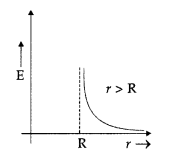
Question 45.
A point charge +Q is placed in the vicinity of a conducting
surface. Draw the electric field lines between the surface and the charge.
(Comptt. Outside Delhi 2017)
Answer: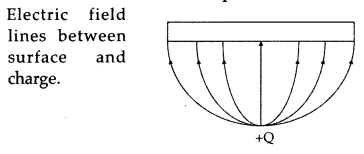
Question 46.
Derive an expression for the torque experienced by an
electric dipole kept in a uniform electric field. (Delhi 2017)
Answer:
Consider an electric dipole consisting of charges + q and – q and of length 2a
placed in a uniform electric field \(\overrightarrow{\mathrm{E}}\) making an
angle θ with it. It has a dipole moment of magnitude,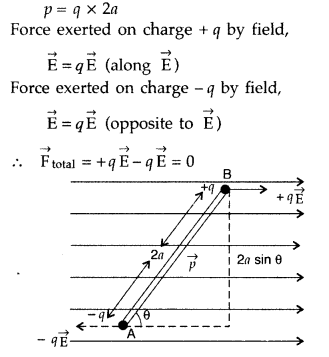
Hence the net translating force on a dipole in a uniform electric field is zero.
But the two equal and opposite forces act at different points of the dipole.
They form a couple which exerts a torque.
Torque = Either force ×
Perpendicular distance between the two forces
x = qE × 2a sin θ
X = pE sin
θ [ ∵ p = q × 2a; p is dipole moment]
As the direction of torque
\(\vec{\tau}\) is perpendicular to \(\vec{p}\) and \(\vec{E}\), so we can write
\(\vec{\tau}=\vec{p} \times \overrightarrow{\mathrm{E}}\)
Question 47.
Define electric flux. Write its S.I. unit.
A charge q is
enclosed by a spherical surface of radius R. If the radius is reduced to half,
how would the electric flux through the surface change? (All India 2009)
Answer:
Electric flux over an area in an electric field is the total number
of lines of force passing through the area. It is represented by ϕ . It is a
scalar quantity. Its S.I unit is Nm2 C-1 or Vm.
Electric flux ϕ by qenclosed
Hence the electric
flux through the surface of sphere remains same.
Question 48.
A spherical conducting shell of inner radius rx and outer
radius r2 has a charge ‘Q’. A charge ‘q’ is placed at the centre of the
shell.
(a) What is the surface charge density on the
(i) inner
surface,
(ii) outer surface of the shell?
(b) Write the expression for the
electric field at a point x > r2 from the centre of the shell.
Answer:
(a) Surface charge density on the :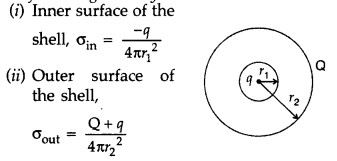
(b) Electric field at a point x > r2 from the centre of the shell
will be E = \(\frac{1}{4 \pi
\varepsilon_{0}}\left(\frac{q+Q}{x^{2}}\right)\)
Question 49.
Show that the electric field at the surface of a charged
conductor is given by
\(\overrightarrow{\mathrm{E}}=\frac{\sigma}{\varepsilon_{0}} \hat{n}\), where σ
is the surface charge density and h is a unit vector normal to the surface in
the outward direction. (All India 2010)
Answer:
Electric field at a point
on the surface of charged conductor, E = \(\frac{1}{4 \pi \varepsilon_{0}}
\frac{Q}{R^{2}}\)
For simplicity we consider charged conductor as a sphere of
radius ‘R’. If ‘σ’ is in surface charge density, then
…where
[ \(\hat{\boldsymbol{n}}\) is a unit vector normal to the surface in the outward
direction]
Question 50.
Consider the situation shown in the figure given below. What
are the signs of q1 and q2?
Answer: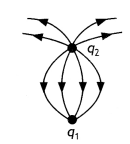
q1 is negative and q2 is positive.
Question 51.
In the figure given below, at which point electric field is
maximum?
Answer: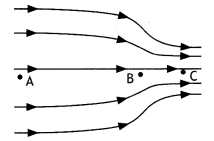
The electric field is maximum at point C.
Question 52.
An uncharged insulated conductor A is brought near a charged
insulated conductor B. What happens to the charge and potential of B?
Answer:
On bringing uncharged conductor A near a charged conductor B, charges
are induced on A as shown in the figure below. As a result, the potential of
conductor B is slightly lowered but the charge on it remains unchanged.
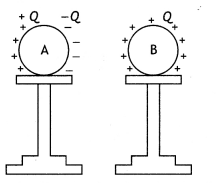
Question 53.
In a medium the force of attraction between two point
electric charges, distance ‘d’ apart, is F. What distance apart should these be
kept in the same medium so that the force between them becomes 3F?
Answer:
Let the new distance be ‘d’, since F ∝\(\frac{1}{r^{2}}\) ,
therefore \(\frac{F}{3 F}=\frac{r^{2}}{d^{2}}=\frac{1}{3} \Rightarrow
r=\frac{d}{\sqrt{3}}\)
Question 54.
Find the value of an electric field that would completely
balance the weight of an electron.
Answer:
mg = eE ⇒ E = \(\frac{m
g}{e}\)
= \(\frac{9.1 \times 10^{-31} \times 9.8}{1.6 \times 10^{-19}}=5.57
\times 10^{-11} \mathrm{Vm}^{-1}\)
Question 55.
Two charges, one +5 µC, and the other -5 µC are placed 1 mm
apart. Calculate the electric dipole moment of the system.
Answer:
p = q ×
2a = 5 × 10 -6 × 10-3 = 5 × 10-9 Cm
Question 56.
Two-point charges of+3 µC each are 100 cm apart. At what
point on the line joining the charges will the electric intensity be zero?
Answer:
At the mid-point of the line joining the two point charges.
Question 57.
Four charges of came magnitude and same sign are placed at
the corners of a square, of each side 0.1 m. What is electric field intensity at
the center of the square?
Answer:
Zero.
Question 58.
Why should the electrostatic field be zero ‘ inside a
conductor?
Answer:
Because it does not contain any
charge.
Question 59.
A metallic spherical shell has an inner radius R1
and outer radius R2. A charge Q is placed at the center of the shell.
What will be the surface charge density on the (i) inner surface, and (ii) the
outer surface of the shell?
Answer:
On inner
surface![]()
On the outer surface,
Question 60.
An arbitrary surface encloses a dipole. What is the electric
flux through this surface?
Answer:
Zero.
Question 61.
A thin straight infinitely long conducting wire having charge
density X is enclosed by a cylindrical surface of radius r and length l, its
axis coinciding with the length of the wire. Find the expression for the
electric flux through the surface of the cylinder. (All India 2011)
Answer:
Since the field is everywhere radial, flux through the two ends of
the cylindrical Gaussian surface is zero. At the cylindrical part of the
surface, E is normal to the surface at every point, and its magnitude is
constant, since it depends only on r. The surface area of the curved part is
2πrl, where l is the length of the cylinder.
Flux through the Gaussian surface = Flux through the curved cylindrical part of the surface is zero. At the cylindrical part of the surface, E is normal to the surface at every point, and its magnitude is constant, since at every point, and its magnitude is constant, since it depends only on r. The surface area of the cylinder.
Flux through the Gaussian surface = Flux through the curved cylindrical part
of the surface
= E × 2πrl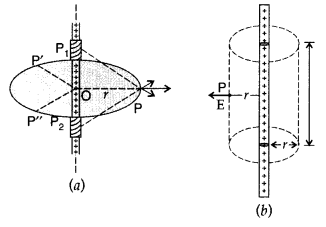
(a) Electric field due to an infinitely long thin straight wire is radial.
(b) The Gaussian surface for a long thin wire of uniform linear charge
density
The surface includes charge equal to λl.
Gauss’s law then
gives
Question 62.
Plot a graph showing the variation of coulomb force (F)
versus \(\left(\frac{1}{r^{2}}\right)\), where r is the distance between the two
charges of each pair of charges : (1µC, 2µC) and (2µC, – 3µC). Interpret the
graphs obtained.
Answer: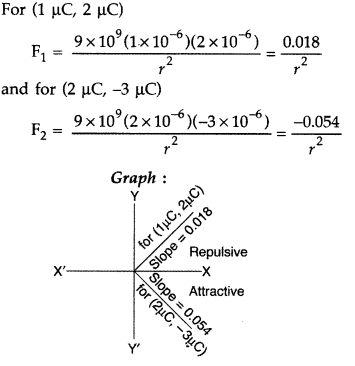
Here positive slope depicts that force is repulsive in nature and negative slope
depicts that the force is attractive in nature.
Question 63.
A hollow cylindrical box of length 1m and area of
cross-section 25 cm2 is placed in a three dimensional coordinate
system as shown in the figure. The electric field in the region is given by
\(\overrightarrow{\mathbf{E}}=50 x \hat{i}\) where E is in NC-1 and x
is in metres. Find
- Net flux through the cylinder.
- Charge enclosed by the cylinder.
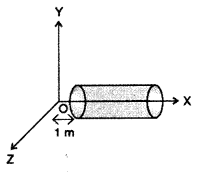
Answer: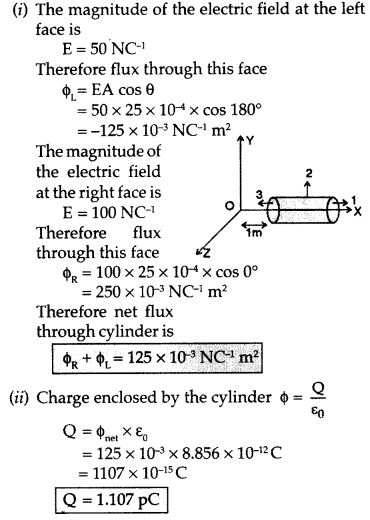
Question 64.
Given a uniform electric field ![]() , find the flux of this field through a square of 10 cm on a side
whose plane is parallel to the y-z plane. What would be the flux through the
same square if the plane makes a 30° angle with the x-axis? (Delhi 2014)
, find the flux of this field through a square of 10 cm on a side
whose plane is parallel to the y-z plane. What would be the flux through the
same square if the plane makes a 30° angle with the x-axis? (Delhi 2014)
Answer:
Given : \(\overrightarrow{\mathrm{E}}=5 \times 10^{3} \hat{i}
\mathrm{N} / \mathrm{C}\)
A = 10 × 10 × 10-4m2,
Flux
(ϕ) = EA cos θ
(i) For first case, θ = 0, cos 0 = 1
∴ Flux = (5 ×
103) × (10 × 10 × 10-4)
(ii) Angle of square plane with
x-axis = 30°
Hence the 0 will be 90° – 30° = 60°
EA cos θ = (5 ×
103) × (10 × 10 × 10-4) × cos 60
= 50 ×
\(\frac{1}{2}\)
= 25 Nm2C-1
Question 65.
Given a uniform electric field
\(\overrightarrow{\mathbf{E}}\) = 2 × 103 \(\hat{i}\) N/ C, find the
flux of this field through a square of side 20 cm, whose plane is parallel to
the y-z plane. What would be the flux through the same square, if the plane
makes an angle of 30° with the x-axis? (Delhi 2014)
Answer:
Given :
\(\overrightarrow{\mathrm{E}}=5 \times 10^{3} \hat{i} \mathrm{N} /
\mathrm{C}\)
A = 10 × 10 × 10-4m2,
Flux (ϕ) = EA cos
θ
(i) For first case, θ = 0, cos 0 = 1
∴ Flux = (5 × 103) × (10
× 10 × 10-4)
(ii) Angle of square plane with x-axis = 30°
Hence
the 0 will be 90° – 30° = 60°
EA cos θ = (5 × 103) × (10 × 10 ×
10-4) × cos 60
= 50 × \(\frac{1}{2}\)
= 25
Nm2C-1
Hint : (i) 80 Nm2C-1
(ii) 40 Nm2C3
Question 66.
Given a uniform electric field
\(\overrightarrow{\mathrm{E}}=4 \times 10^{3} \hat{i}\) N/C. Find the flux of
this field through a square of 5 cm on a side whose plane is parallel to the Y-Z
plane. What would be the flux through the same square if the plane makes a 30°
angle with the x-axis? (Delhi 2014)
Answer:
Given :
\(\overrightarrow{\mathrm{E}}=5 \times 10^{3} \hat{i} \mathrm{N} /
\mathrm{C}\)
A = 10 × 10 × 10-4m2,
Flux (ϕ) = EA cos
θ
(i) For first case, θ = 0, cos 0 = 1
∴ Flux = (5 × 103) × (10
× 10 × 10-4)
(ii) Angle of square plane with x-axis = 30°
Hence
the 0 will be 90° – 30° = 60°
EA cos θ = (5 × 103) × (10 × 10 ×
10-4) × cos 60
= 50 × \(\frac{1}{2}\)
= 25
Nm2C-1
Hint:
(i) 10 Nm2C-1
(ii) 5 Nm2C-1
Question 67.
A small metal sphere carrying charge +Q is located at the
centre of a spherical cavity in a large uncharged metallic spherical shell.
Write the charges on the inner and outer surfaces of the shell. Write the
expression for the electric field at the point P1 (Comptt.
Delhi)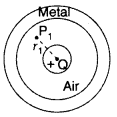
Answer:
- Charge on inner surface : – Q
- Charge on outer surface : + Q
- Electric field at point P1 (E) = \(\frac{1}{4 \pi \varepsilon_{0}} \frac{Q}{r_{1}^{2}}\)
Question 68.
An electric dipole is placed in a uniform electric field
\(\overrightarrow{\mathbf{E}}\) with its dipole moment \(\vec{p}\) parallel to
the field. Find
(i) the work done in turning the dipole till its dipole
moment points in the direction
opposite to \(\overrightarrow{\mathbf{E}}\)
.
(ii) the orientation of the dipole for which the torque acting on it
becomes maximum.
Answer: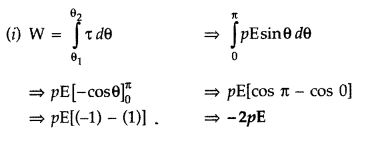
(ii) τ = \(\vec{p} \times \overrightarrow{\mathrm{E}}\) = pE sin θ
For θ =
\(\frac{\pi}{2}\), sin θ = 1 and τ is maxximum
Question 69.
A sphere S1 of radius r1 encloses a net
charge Q. If there is another concentric sphere S2 of radius
r2 (r2 > r,) enclosing charge 2Q, find the ratio of the
electric flux through S1 and S2. How will the electric
flux through sphere S1 change if a medium of dielectric constant K is
introduced in the space inside S2 in place of air? (Comptt. All India
2014)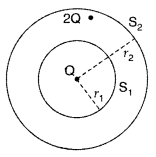
Answer: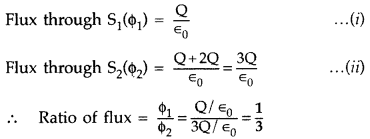
Therefore, there will be no change in the flux through S1 on
introducing dielectric medium inside the sphere S2.
Question 70.
Define the term ‘electric flux’. Write its S.I. units. What
is the flux due to electric field \(\overrightarrow{\mathbf{E}}=3 \times 10^{3}
\hat{i}\) N/C through a square of side 10 cm, when it is held normal to if?
(Comptt. All India 2015)
Answer:
Electric flux over an area in an electric field is the total number of lines
of force passing through the area. It is represented by ϕ . It is a scalar
quantity. Its S.I unit is Nm2 C-1 or Vm.
Electric flux ϕ by qenclosed
Hence the electric
flux through the surface of sphere remains same.
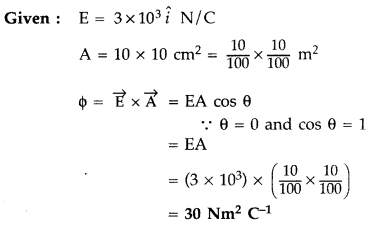
Short Answer Type
Question 1.
(a) Electric field inside a conductor is zero. Explain.
(b)
The electric field due to a point charge at any point near it is given as
E =![]()
what is the physical significance of this limit?
Answer:
(a) By Gauss
theorem \(\phi \vec{E} \cdot \overrightarrow{d S}=\frac{q}{\varepsilon_{0}}\).
Since there is no charge inside a conductor therefore in accordance with the
above equation the electric field inside the conductor is zero.
(b) It
indicates that the test charge should be infinitesimally small so that it may
not disturb the electric field of the source charge.
Question 2.
Define the electric line of force and give its two important
properties.
Answer:
It is a line straight or curved, a tangent to which at
any point gives the direction of the electric field at that point.
(a) No two
field lines can cross, because at the point of intersection two tangents can be
drawn giving two directions of the electric field which is not possible.
(b)
The field lines are always perpendicular to the surface of a charged
conductor.
Question 3.
Draw electric field lines due to (i) two similar charges, (ii)
two opposite charges, separated by a small distance.
Answer:
(a) The
diagram is as shown.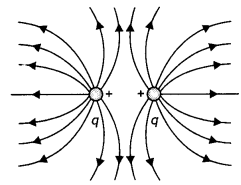
(b) The diagram is as shown.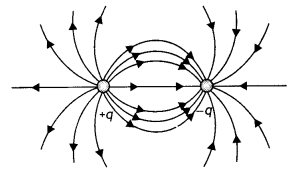
Question 4.
An electric dipole is free to move in a uniform electric field.
Explain what is the force and torque acting on it when it is placed
(i)
parallel to the field
Answer:
When an electric dipole is placed parallel
to a uniform electric field, net force, as well as net torque acting on the
dipole, is zero and, thus, the dipole remains in equilibrium.
(ii) perpendicular to the field
Answer:
When the dipole is placed
perpendicular to the field, two forces acting on the dipole form a couple, and
hence a torque acts on it which aligns its dipole along the direction of the
electric field.
Question 5.
A small metal sphere carrying charge +Q. is located at the
center of a spherical cavity in a large uncharged metallic spherical shell.
Write the charges on the inner and outer surfaces of the shell. Write the
expression for the electric field at the point P1
Answer: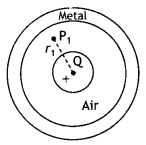
Charge on inner surface – Q.
Charge on outer surface + Q,
Electric field
at point P = E = k\(\frac{Q}{r_{1}^{2}}\)
Question 6.
Two-point charges q and –2q are kept ‘d’ distance apart. Find
the location of the point relative to charge ‘q’ at which potential due to this
system of charges is zero.
Answer:
Let the potential be
zero at point P at a distance x from charge q as shown
Now potential at point P is
V = \(\frac{k q}{x}+\frac{k(-2 q)}{d+x}\) = 0
Solving for x we have
x = d
Question 7.
A thin conducting spherical shell of radius R has charge Q
spread uniformly over its surface. Using Gauss’s law, derive an expression for
an electric field at a point outside the shell.
Draw a graph of electric
field E(r) with distance r from the centre of the shell for 0 ≤ r ≤ ∞
Answer:
Electric field at a point outside the shell :
(a) (i) To find out
electric field at a point outside a spherical charged shell we imagine a
symmetrical Gaussian surface in such a way that the point lies on it.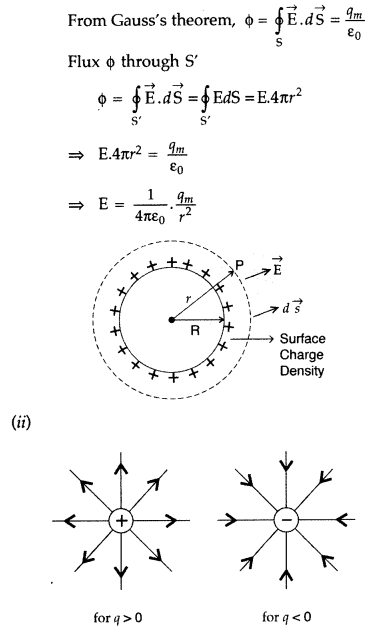
Graph of electric field E(r) :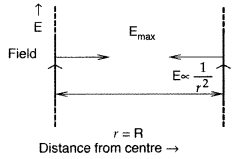
Question 8.
State Gauss’ law in electrostatics. Using this law derive an
expression for the electric field due to a uniformly changed infinite plane
sheet.
Answer:
Gauss’ Law states that “the total flux through a closed
surface is \(\frac{1}{\varepsilon_{0}}\) times the net charge enclosed
by![]()
Let σ be the surface charge density (charge per unit area) of
the given sheet and let P be a point at distance r from the sheet where we have
to find \(\overrightarrow{\mathrm{E}}\)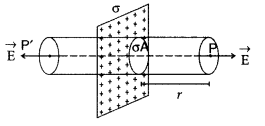
Choosing point P’, symmetrical with P on the other side of
the sheet, let us draw a Gaussian cylindrical surface cutting through the sheet
as shown in the diagram. As at the cylindrical part of the Gaussian surface,
\(\overrightarrow{\mathrm{E}}\) and \(d \overrightarrow{\mathrm{S}}\) are at a
right angle, the only surfaces having \(\overrightarrow{\mathrm{E}}\) and \(d
\overrightarrow{\mathrm{S}}\) parallel are the plane ends
…[As
E is outgoing from both plane ends, the flux is positive.
This is the total
flux through the Gaussian surface.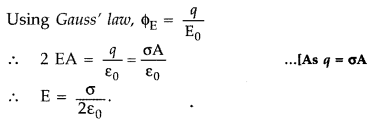
This value is independent of r. Hence, the electric field intensity is same for
all points near the charged sheet. This is called uniform electric field
intensity.
Question 9.
State ‘Gauss law’ in electrostatics. Use this law to derive
an expression for the electric field due to an infinitely long straight wire of
linear charge density λ cm-1
Answer:
Gauss’s law in
electrostatics : It states that “the total electric flux over the surface S in
vaccum is \(\frac{1}{\varepsilon_{0}}\) times the total charge (q).”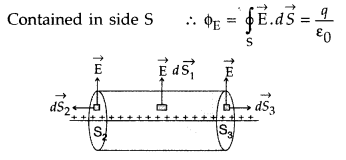
Electric
field due to an infinitely long straight wire : Consider an infinitely long
straight line charge having linear charge density X to determine its electric
field at distance r. Consider a cylindrical Gaussian surface of radius r and
length l coaxial with the charge. By symmetry, the electric field E has same
magnitude at each point of the curved surface S1 and is directed
radially outward.
Total flux through the cylindrical surface,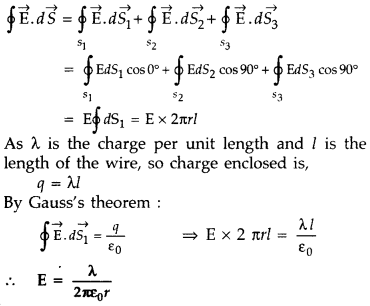
Question 10.
A positive point charge (+ q) is kept in the vicinity of an
uncharged conducting plate. Sketch electric field lines originating from the
point on to the surface of the plate.
Derive the expression for the electric
field at the surface of a charged conductor. (All India) Answer: Representation
of electric field, (due to a positive charge)
Answer:
Representation of
electric field. (due to a positive charge)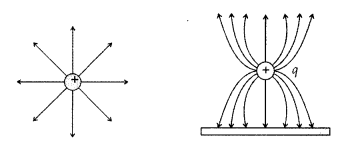
Question 11.
Use Gauss’s law to derive the expression for the electric
field between two uniformly charged large parallel sheets with surface charge
densities a and -a respectively. (All India)
Answer:
Gauss’ Law states that “the total flux through a closed surface is
\(\frac{1}{\varepsilon_{0}}\) times the net charge enclosed by![]()
Let σ be the surface charge density (charge per unit area) of
the given sheet and let P be a point at distance r from the sheet where we have
to find \(\overrightarrow{\mathrm{E}}\)
Choosing point P’, symmetrical with P on the other side of
the sheet, let us draw a Gaussian cylindrical surface cutting through the sheet
as shown in the diagram. As at the cylindrical part of the Gaussian surface,
\(\overrightarrow{\mathrm{E}}\) and \(d \overrightarrow{\mathrm{S}}\) are at a
right angle, the only surfaces having \(\overrightarrow{\mathrm{E}}\) and \(d
\overrightarrow{\mathrm{S}}\) parallel are the plane ends
…[As
E is outgoing from both plane ends, the flux is positive.
This is the total
flux through the Gaussian surface.
This value is independent of r. Hence, the electric field intensity is same for
all points near the charged sheet. This is called uniform electric field
intensity.
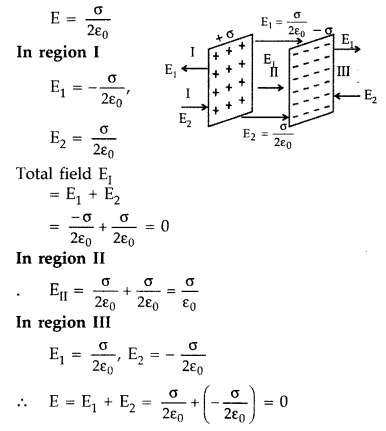
Question 12.
State Gauss’s law.
A thin straight infinitely long
conducting wire of linear charge density ‘X’ is enclosed by a cy¬lindrical
surface of radius V and length ‘l’—its axis coinciding with the length of the
wire. Obtain the expression for the electric field, indi¬cating its direction,
at a point on the surface of the cylinder. (Comptt. Delhi 2012)
Answer:
Gauss’s law. Gauss law states that “Total flux (electric flux) over the closed
surfaces in vacuum is He0 times the total charge (Q) contained inside
S.”![]()
Since the field is everywhere radial, flux through the two ends of the cylindrical Gaussian surface is zero. At the cylindrical part of the surface, E is normal to the surface at every point, and its magnitude is constant, since it depends only on r. The surface area of the curved part is 2πrl, where l is the length of the cylinder.
Flux through the Gaussian surface = Flux through the curved cylindrical part of the surface is zero. At the cylindrical part of the surface, E is normal to the surface at every point, and its magnitude is constant, since at every point, and its magnitude is constant, since it depends only on r. The surface area of the cylinder.
Flux through the Gaussian surface = Flux through the curved cylindrical part
of the surface
= E × 2πrl
(a) Electric field due to an infinitely long thin straight wire is radial.
(b) The Gaussian surface for a long thin wire of uniform linear charge
density
The surface includes charge equal to λl.
Gauss’s law then
gives
Question 13.
(a) Define electric flux. Write its S.I. units.
(b)
Consider a uniform electric field
\(\overrightarrow{\mathrm{E}}\) = 3 ×
103 \(\hat{\mathbf{i}}\) N/C. Calculate the flux of this field
through a square surface of area 10 cm2 when
(i) its plane is
parallel to the y-z plane, and
(ii) the normal to its plane makes a 60° angle
with the x-axis. (Comptt. Delhi 2013)
Answer:
(a)
Electric flux over an
area in an electric field is the total number of lines of force passing through
the area. It is represented by ϕ . It is a scalar quantity. Its S.I unit is
Nm2 C-1 or Vm.
Electric flux ϕ by qenclosed
Hence the electric
flux through the surface of sphere remains same.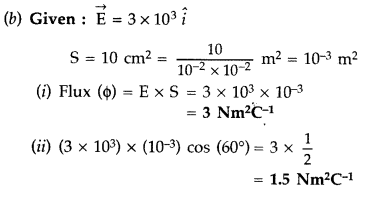
Question 14.
Two charged spherical conductors of radii R1 and
R2 when connected by a conducting wire acquire charges q1
and q2 respectively. Find the ratio of their surface charge densities
in terms of their radii. (Delhi 2014)
Answer:
Two charged spherical
conductors of radii R1 and R2 when connected by a
conducting wire acquire charges q1 and q2 respectively.
Thus these two conductors have a common potential V.
Two charged spherical
conductors of radii R1 and R2 when connected by a conduction wire acquire
charges q1 and q2 respectively. Thus these two conductors have a common
potential V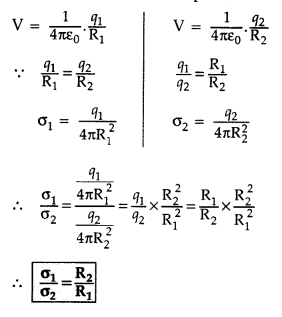
Question 15.
Two point charges + q and -2q are placed at the vertices ‘B’
and ‘C’ of an equilateral triangle ABC of side as given in the figure. Obtain
the expression for (i) the magnitude and (ii) the direction of the resultant
electric field at the vertex A due to these two charges.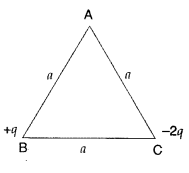
(Comptt All India)
Answer:
Question 16.
Two point charges + 3q and – 4q are placed at the vertices
‘B’ and ‘C’ of an equilateral triangle ABC of side ‘a’ as given in the figure.
Obtain the expression for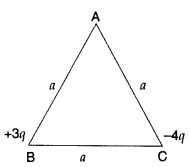
(i) the magnitude and
(ii) the direction of the resultant
electric field at the vertex A due to these two charges. (Comptt. All India
2014)
Answer: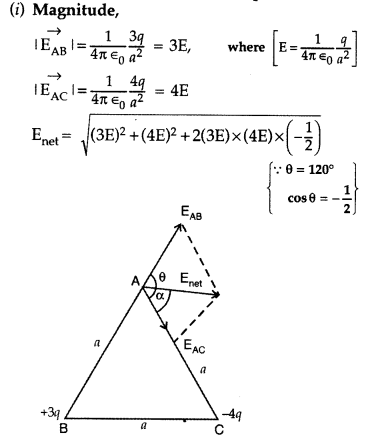
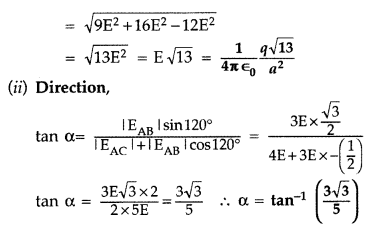
Question 17.
An electric dipole of dipole moment \(\overrightarrow { p }
\) is placed in a uniform electric field \(\overrightarrow { E } \)?. Obtain the
expression for the torque \(\overrightarrow { \tau } \)experienced by the
dipole. Identify two pairs of perpendicular vectors in the expression. (Comptt.
Delhi 2015)
Answer:
(i)
(a) Torque on electric dipole. Consider an
electric dipole consisting of two equal and opposite point charges separated by
a small distance 2a having dipole moment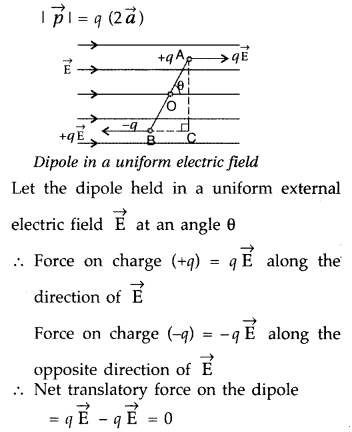
So net force on the dipole is zero
Since ![]() is uniform, hence the dipole does not undergo any translatory
motion.
is uniform, hence the dipole does not undergo any translatory
motion.
These forces being equal, unlike and parallel, from a couple, which rotates
the dipole in clock-wise direction
∴ Magnitude of torque = Force × arm of
couple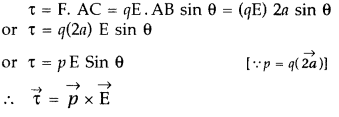
[The direction of \(\vec{\tau} \) is given by right hand screw rule and is
normal to \(\vec{p} \) ] and \(\vec{E} \)
Special cases
(i) when θ =
0 then τ = PE sin θ = 0
∴ Torque is zero and the dipole is in stable
equilibrium
(ii) When θ = 90 then τ = PE sin 90 = PE
∴ The Torque is
maximum
(b) Ratio of flux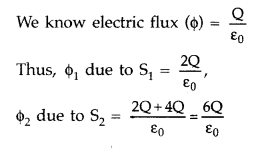

∴ Electric flux through the sphere S1 decreases with the introduction
of dielectric inside it.
(ii) Two pairs of perpendicular vectors are,
(a) \(\overrightarrow { \tau
} \) is perpendicular to \(\overrightarrow { p } \)
(b) \(\overrightarrow {
\tau } \)is perpendicular to \(\overrightarrow { E } \)
Question 18.
(a) Two spherical conductors of radii Ra and R2
(R2 > R1) are charged. If they are connected by a
conducting wire, find out the ratio of the surface charge densities on them.
(b) A steady current flows in a metallic conductor of non-uniform cross-section.
Which of these quantities is constant along the conductor : current, current
density, electric field, drift speed? (Comptt. Delhi 2015)
Answer:
(a)
When two charged spherical conductors of Radii R1 and R2
respectively (R2 > R1) are connected by a conducting
wire, we know that the common potential (V) is given by,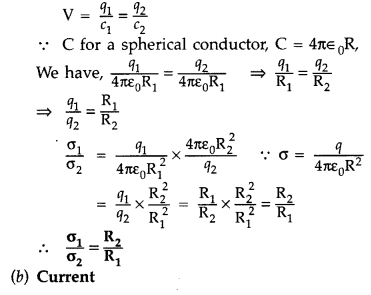
Question 19.
A charge is distributed uniformly over a ring of radius ‘a’.
Obtain an expression for the electric intensity E at a point on the axis of the
ring. Hence show that for points at large distances from the ring, it behaves
like a point charge. (Delhi 2016)
Answer:
Electric Intensity on the axis
of a ring: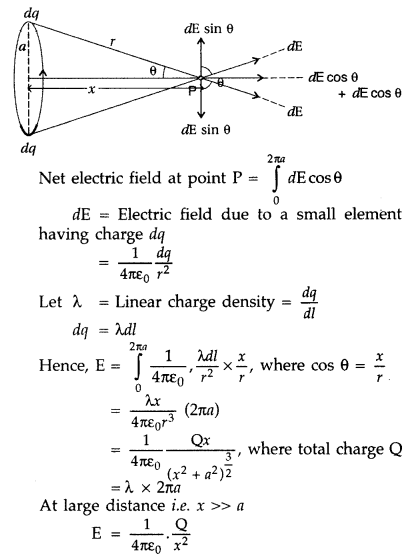
This is the Electric Field due to a point charge at distance x.
Question 20.
Two thin concentric and coplanar spherical shells, of radii a
and b (b > a) carry charges, q and Q, respectively. Find the magnitude of the
electric field, at a point distant x, from their common centre for
(i) 0 <
x < a
(ii) a ≤ x < b
(iii) b ≤ x < ∞ (Comptt. Delhi 2016) Answer:
Magnitude of Electric field : Two thin concentric and coplanar spherical shells
of radii ‘a’ and ‘b’ (b > a) carry charges ‘q’ and ‘Q’ respectively.
(i)
For 0 < x < a
Point lies inside both the spherical shells.
Hence,
E(x) = 0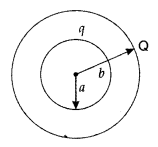
(ii) For a ≤ x < b
Point is outside the spherical shell
of radius ‘a’ but inside the spherical shell of radius ‘b’.
∴ E(x) =
\(\frac{1}{4 \pi \varepsilon_{0}} \cdot \frac{q}{x^{2}}\)
(iii) For b ≤
x
< ∞
Point is outside of both the spherical shells. Total effective charge
at the centre equals (Q + q).
E(x) = \(\frac{1}{4 \pi \varepsilon_{0}} \cdot
\frac{(q+Q)}{x^{2}}\)
Question 21.
A charge +Q, is uniformly distributed within a sphere of
radius R. Find the electric field, due to this charge distribution, at a point
distant r from the centre of the sphere where :
(i) 0 < r < R and
(ii) r > R (Comptt. Outside Delhi )
Answer:
We have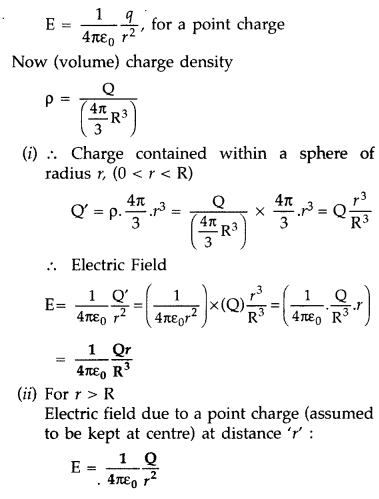
Question 22.
(i) Derive the expression for electric field at a point on
the equatorial line of an electric dipole.
(ii) Depict the orientation of the
dipole in
(a) stable,
(b) unstable equilibrium in a uniform electric
field. (Delhi 2017)
Answer:
(i)
Electric dipole moment: It is the product of the magnitude of either charge
and distance between them.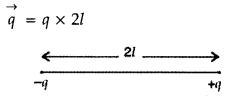
It is a vector quantity whose direction is from negative to
positive charge.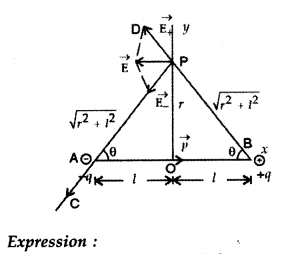
Electric field intensity at P due to +q charge is
Electric field intensity at P due to -q charge is,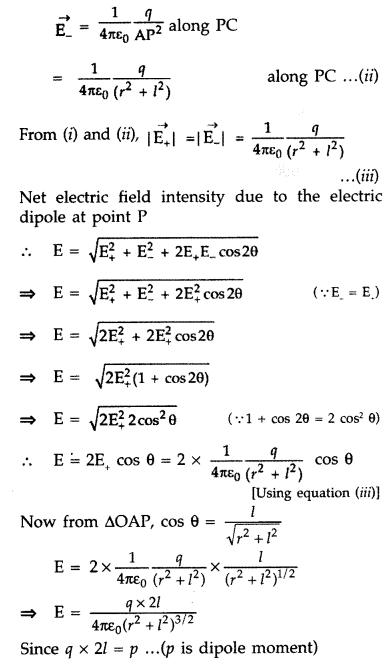
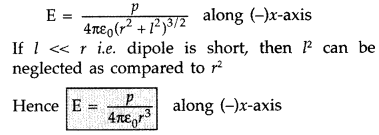
(ii) (a) For stable equilibrium, the angle between p and E is 0°,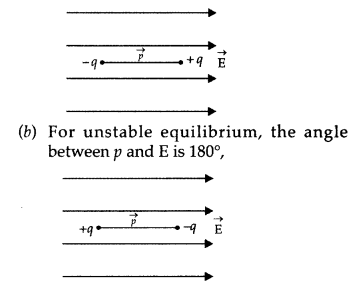
(b) For unstable equilibrium, the angle between p and E is 180°,
Question 23.
(i) Obtain the expression for the torque \(\vec{\tau} \)
experienced by an electric dipole of dipole moment \(\vec{p} \) in a uniform
electric \(\overrightarrow{\mathbf{E}} \)?
(ii) What will happen if the field
were not uniform? (Delhi 2017)
Answer:
(i)
(a) Torque on electric
dipole. Consider an electric dipole consisting of two equal and opposite point
charges separated by a small distance 2a having dipole moment
So net force on the dipole is zero
Since ![]() is uniform, hence the dipole does not undergo any translatory
motion.
is uniform, hence the dipole does not undergo any translatory
motion.
These forces being equal, unlike and parallel, from a couple, which rotates
the dipole in clock-wise direction
∴ Magnitude of torque = Force × arm of
couple
[The direction of \(\vec{\tau} \) is given by right hand screw rule and is
normal to \(\vec{p} \) ] and \(\vec{E} \)
Special cases
(i) when θ =
0 then τ = PE sin θ = 0
∴ Torque is zero and the dipole is in stable
equilibrium
(ii) When θ = 90 then τ = PE sin 90 = PE
∴ The Torque is
maximum
(b) Ratio of flux

∴ Electric flux through the sphere S1 decreases with the introduction
of dielectric inside it.
(ii) If the electric field is non uniform, the dipole experiences a translatory force as well as a torque.
Question 24.
State Gauss’s law in electrostatics. Derive an expression for
the electric field due to an infinitely long straight uniformly charged wire.
(Comptt. Delhi 2017)
Answer:
Gauss Theorem : The surface integral of
electric field over a closed surface is equal to \(\frac { 1 }{ { \epsilon }_{ 0
} } \) times the charge enclosed by the surface.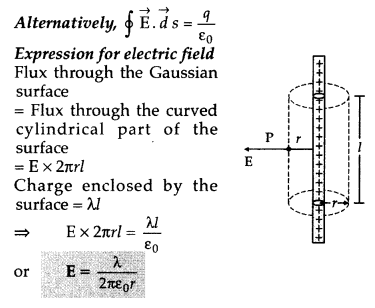
Question 25.
Two small identical electrical dipoles AB and CD, each of
dipole moment ‘p’ are kept at an angle of 120° as shown in the figure. What is
the resultant dipole moment of this combination? If this system is subjected to
the electric field (\(\vec{E}\)) directed along +X direction, what will be the
magnitude and direction of the torque acting on this? 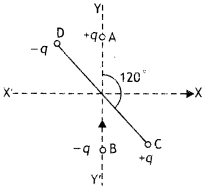
Answer:
The resultant dipole moment of the combi-nation is
PR =
\(\sqrt{p^{2}+p^{2}+2 p^{2} \cos 120^{\circ}}\) = p
since cos 120° = -1/2
This will make an angle of 30° with the X-axis,
therefore torque acting on it is
τ=PE sin 30° = pE/2 (Along Z-direction)
Question 26.
A metallic spherical shell has an inner radius R1
and outer radius R2. A charge Q is placed at the center of the
spherical cavity. What will be surface charge density on (i) the inner surface,
and (ii) the outer surface?
Answer:
The induction of
charges is as shown.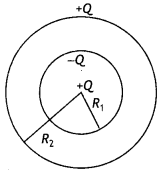
Therefore surface charge density on the inner and the outer shell is on the
outer surface is![]()
![]()
Question 27.
If the total charge enclosed by a surface is zero, does it
imply that the electric field everywhere on the surface is zero? Conversely, if
the electric field everywhere on a surface is zero, does it imply that the net
charge inside is zero.
Answer:
No, the field may be
normal to the surface. However, the converse is true i.e. when the electric
field everywhere on the surface be zero then the net charge inside it must be
zero.
Long Answer Type
Question 1.
(a) State Gauss theorem in electrostatics. Using it, prove
that the electric field at a point due to a uniformly charged infinite plane
sheet is independent of the distance from it.
Answer:
It states, “The net
electric flux through any Gaussian surface is equal to
\(\frac{1}{\varepsilon_{0}}\) times the net electric charge enclosed by the
surface.
Mathematically, Φ =\( \phi \vec{E} \cdot d \vec{A}=\frac{q_{i n}}{\varepsilon_{0}}\)
Consider an infinite plane sheet of charge. Let a be the uniform surface charge density, i.e. the charge per unit surface area. From symmetry, we find that the electric field must be perpendicular to the plane of the sheet and that the direction of E on one side of the plane must be opposite to its direction on the other side as shown in the figure below. In such a case let us choose a Gaussian surface in the form of a cylinder with its axis perpendicular to the sheet of charge, with ends of area A.
The charged sheet passes through the middle of the cylinder’s length so that the cylinder’s ends are equidistant from the sheet. The electric field has a normal component at each end of the cylinder and no normal component along the curved surface of the cylinder. As a result, the electric flux is linked with only the ends and not the curved surface.
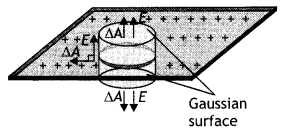
Therefore by the definition of eLectric flux, the flux Linked with the Gaussian
surface is given by
Φ = \(\oint_{A} \vec{E} \cdot \vec{\Delta} A\)
Φ =
EA + EA = 2EA … (1)
But by Gauss’s Law
Φ = \(\frac{q}{\varepsilon_{0}}=\frac{\sigma
A}{\varepsilon_{0}}\) [∵ q = σA] … (2)
From equations (1) and (2), we have
2EA = \(\frac{\sigma
A}{\varepsilon_{0}}\) … (3)
E = \(\frac{\sigma}{2 \varepsilon_{0}}\) ….
(4)
This gives the electric field due to an infinite plane sheet of charge which is independent of the distance from the sheet.
(b) How is the field directed if (i) the sheet is positively charged, (ii)
negatively charged?
Answer:
(a) directed outwards
(b)
directed inwards.
Question 2.
Use Gauss’s law to derive the expression for the electric
field (\(\vec{E}\) ) due to a straight uniformly charged infinite line of charge
λ Cm-1.
Answer: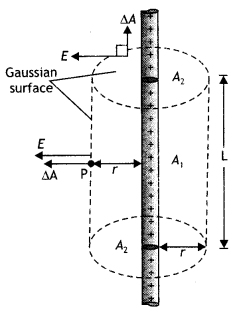
Consider an infinitely Long, thin wire charged positively and having uniform
Linear charge density λ. The symmetry of the charge distribution shows that must
be perpendicular to the tine charge and directed outwards. As a result of this
symmetry, we consider a Gaussian surface in the form of a cylinder with
arbitrary radius r and arbitrary Length L. with its ends perpendicular to the
wire as shown in the figure. Applying Gauss’s theorem to curved surface
ΔA1 and circular surface ΔA2.
Φ EΔA1 cos 0°+ EΔA2 cos 90° = \(\frac{q}{\varepsilon_{0}}\) = \(\frac{\lambda
l}{\varepsilon_{0}}\) [∵ λ = \(\frac{q}{e}\)]
Or
E . 2πrl =
\(\frac{\lambda l}{\varepsilon_{0}}\) ⇒ E = \(\frac{1}{2 \pi \varepsilon_{0}}
\frac{\lambda}{r}\)
This is the expression for the electric field due to an infinitely long thin
wire.
The graph is as shown.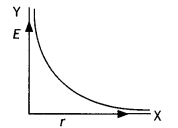
Question 3.
Obtain the expression for the potential energy of an electric
dipole placed with its axis at an angle (θ) to an external electric field (E).
What is the minimum value of the potential energy?
Answer:
The torque x acting on an electric dipole of dipole moment p placed in a uniform
electric field E is given by:
τ = pEsinθ …(i)
where θ is the angle made by
the dipole with the electric field E. The torque tends to align the dipole along
the direction of the field. If the dipole is rotated through a small angle dθ
against the torque, work has to be done, which is stored in the form of the
potential energy of the dipole.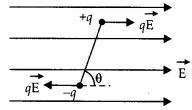
Work done in rotating the dipole through the angle dθ against the torque τ is
given by dw = τ dθ = pE sin θ dθ
If the dipole is rotated from θ1 to θ2, then
Total
work is done,
W = – pE(cos θ2 – cos θ1)
This work done is stored as potential energy U.
U = – pE(cos θ2 – cos θ1)
If the dipole is rotated
from θ1 = \(\frac{\pi}{2}\) to θ2 =θ, then
U = – pE(cos θ – cos \(\frac{\pi}{2}\) )
= – pE(cos θ – 0)
U = – pE cos θ
minimum value of potential energy
U = – pE When θ =
0°
Question 4.
Why does the electric field inside a dielectric decrease when
it is placed in an external electric field?
Answer:
When a dielectric is
placed in an electric field (E0), it gets polarised, i.e. within the
dielectric, an electric field (E) is induced in a direction opposite to that of
the external field. Therefore, the net field within the dielectric decreases to
\(\vec{E}_{0}\) – \(\vec{E}\)
Question 5.
Two-point charges +q and -2q are placed at the vertices ‘B’
and ‘C’ of an equilateral triangle ABC of side ‘a’ as given in the figure.
Obtain the expression for (i) the magnitude and (ii) the direction of the
resultant electric field at vertex A due to these two charges. 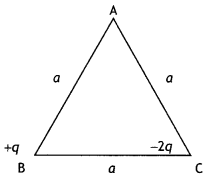
Answer:
The electric fields due to the two charges placed at B and C are
inclined at an angle θ = 120° as shown
Now in magnitude, we have
EB = k\(\frac{q}{a^{2}}\) and
EC =
k\(\frac{2q}{a^{2}}\) = 2 EB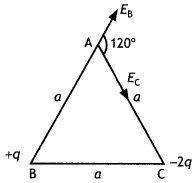
Hence E = \(\sqrt{E_{B}^{2}+E_{c}^{2}+2 E_{B} E_{c} \cos \theta}\)
Or E =
\(\sqrt{E_{B}^{2}+\left(2 E_{B}\right)^{2}+2 E_{B}\left(2 E_{B}\right) \cos
120^{\circ}}\)
On Solving we have
E = \(\sqrt{3} E_{B}\) = \(\sqrt{3} \frac{k
q}{a^{2}}\)
Direction![]()
Therefore B = 90°, the resultant is inclined at an angle of 90° with EB.
Question 6.
Four-point charges Q, q, Q, and q are placed at the corners of
a square of side ‘a’ as shown in the figure.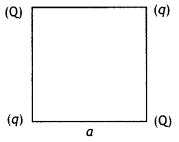
Find the
(a) the resultant electric force on a charge Q and
(b) the
potential energy of this system.
Answer:
(a) Let us
find the force on charge Q at point C.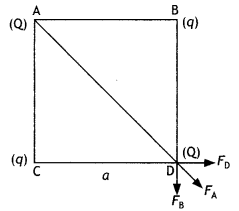
Force due to charge Q placed at point A is
FA = k\(\frac{Q^{2}}{(a
\sqrt{2})^{2}}\) =k\(\frac{Q^{2}}{2 a^{2}}\) along AC
Force due to the charge q placed at D
FD = k\(\frac{q
Q}{a^{2}}\) alongDA
Force due to the charge q placed at B
FB = k \(\frac{q
Q}{a^{2}}\) along BC
The resuLtant of FD and FB is
FBD =
K\(\frac{q Q \sqrt{2}}{a^{2}}\) along AC
∴ net force of charge Q placed at point C is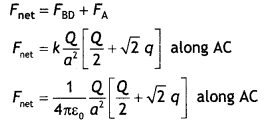
(b) PotentiaL energy of the system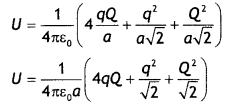
Question 7.
A charge +Q is uniformly distributed within a sphere of radius R.
Find the electric field, distant r from the center of the sphere where: (1) r
< R and (2) r > R.
Answer:
For a solid sphere p = \(
\frac{q}{\frac{4}{3} \pi R^{3}}\) = \(\frac{q}{\text { volume }}\)
Case 1. 0 < r < R The point Lies within the sphere.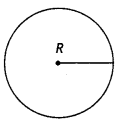
Using Gauss’s theorem
Let Q’ be the charge encLosed by Gaussian’s surface of
radius r < R.
E(4πr²)=\(\frac{Q^{\prime}}{\varepsilon_{0}}=\frac{Q^{\prime}}{4 \pi \varepsilon_{0} r^{2}}\)
From (i) and (ii)
E = \(\frac{Q r^{3}}{4 \pi \varepsilon_{0} r^{2}
R^{3}}=\frac{1}{4 \pi \varepsilon_{0}} \frac{Q r}{R^{3}}\)
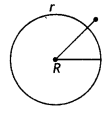
Case 2. For r > R
\(\oint \vec{E} \cdot \overrightarrow{d s}\) =
\(\frac{q_{\text {enclosed }}}{\varepsilon_{0}}\)
E(4πr²) = \(\frac{Q}{\varepsilon_{0}}\)
E = \(\frac{Q}{4 \pi
\varepsilon_{0} r^{2}}\)
Question 8.
(a) An electric dipole is kept first to the left and then to
the right of a negatively charged infinite plane sheet having a uniform surface
charge density. The arrows p1 and p2 show the directions
of its electric dipole moment in the two cases. Identify for each case, whether
the dipole is in stable or unstable equilibrium. Justify each answer.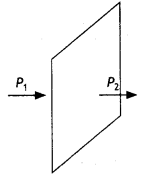
Answer:
p1: stable equilibrium, p2: unstable
equilibrium. The electric field, on either side, is directed towards the
negatively charged sheet and its magnitude is independent of the distance of the
field point from the sheet. For position P1 dipole moment and
electric field are parallel. For position p2, they are
antiparallel.
(b) Next, the dipole is kept in a similar way (as shown), near an infinitely long straight wire having uniform negative linear charge density. Will the dipole be in equilibrium at these two positions? Justify your answer.
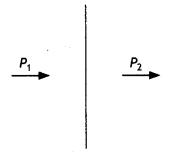
Answer:
The dipole will not be in equilibrium in any of the two
positions.
The electric field due to an infinite straight charged wire is
non-uniform (E ∝ 1/r).
Hence there will be a net non-zero force on the dipole
in each case.
Question 9.
Two large parallel plane sheets have uniform charge densities
+σ and -σ. Determine the electric field (i) between the sheets, and (ii) outside
the sheets.
Answer:
Let us consider two parallel planes
charged conductors A and B carrying +ve and -ve charge density σ (charge per
unit area). According to Gauss’ theorem, the electric intensity at P due to the
charge on sheet A is
EA = \(\frac{\sigma}{2 \varepsilon_{0}}\) (From A and B)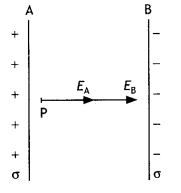
The electric field at P due to charge on sheet B is
E= \(\frac{\sigma}{2
\varepsilon_{0}}\) (From A to B)
The electric field at P is
E = EA + EB
=
\(\frac{\sigma}{\varepsilon_{0}}\)
Question 10.
Define electric flux and write its SI unit. The electric
field components in the figure shown are : Ex = αx, Ey =
0, Ez = 0 where α = 100N/cm. Calculate the charge within the cube,
assuming a = 0.1 m. 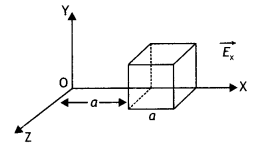
Or
An electron falls through a distance of 1.5 cm in a uniform electric field
of magnitude 2.0 × 104 N/C (figure a)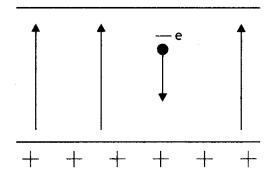
(a) Calculate the time it takes to fall through this distance starting from
rest.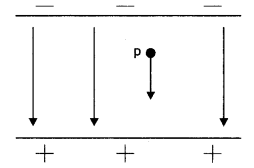
(b) If the direction of the field is reversed (figure b) keeping its magnitude
unchanged, calculate the time taken by a proton to fall through this distance
starting from rest.
Answer:
Electric Flux is the dot
product of the electric field and area vector.
Φ = \(\oint \vec{E} \cdot
\overrightarrow{d s}\)
SI Unit: Nm2/C or Vm
For a given case
Φ = Φ1 – Φ2 = [Ex(atx= 2a) – Ex
(atx = a)]a2
= [α(2a)-α(a)]a2 = αa3
=
104 × (0.1 )3 = 10 Nm2/C
But
Φ =
\(\frac{q}{\varepsilon_{0}}\)
∴ q = ε0Φ = 8.854 × 10-12 × 10 C = 8.54 pC
Or
We
have
F = qE
Acceleration, a = \(\frac{q E}{m}\)
Also
s = \(\frac { 1 }{ 2 }\) at2 [u = 0]
∴ t =
\(\sqrt{\frac{2 s}{a}}\)
(i) For the electron
a = \(\frac { eE}{ m }\)
∴ t = \(\sqrt{\frac{2 s m}{e E}}\)
∴ t = \(\sqrt{\frac{3 \times 10^{-2} \times 9.1 \times 10^{-31}}{1.6 \times 10^{-19} \times 2.0 \times 10^{4}}}\) = 2.92 ns
(ii) for proton
t = \(\sqrt{\frac{2 \times 1.5 \times 10^{-2} \times 1.67
\times 10^{-27}}{1.6 \times 10^{-19} \times 2 \times 10^{4}}}\)
= -.125
μs
Question 11.
What will be the total flux through the faces of the cube
(figure) with the side of length ‘a’ if a charge q is placed at
(a) A: a
corner of the cube.
(b) B: mid-point of an edge of the cube.
(c) C: center
of the face of the cube.
(d) D: mid-point of B and C. {NCERT
Exemplar)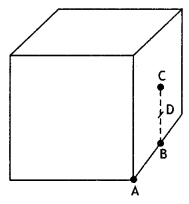
Answer:
(a) The charge wilt is shared by eight cubes if it has to be
enclosed. Therefore the flux through the cube will be one-eighth of the total
flux. Φ = q/8ε0
(b) The charge will be shared by four cubes if it
has to be enclosed. Therefore the flux through the cube will be one-fourth of
the total flux. Φ = q/ 4ε0
(c) The charge will be shared by two
cubes if it has to be enclosed. Therefore the flux through the cube will be
one-half of the total flux. Φ = q/ 2ε0
(d) The charge will be
shared by two cubes if it has to be enclosed. Therefore the flux through the
cube will be one-half of the total flux. Φ = q/ 2ε0
Question 12.
Two charges q and -3q are placed fixed on the x-axis
separated by distance ‘d’. Where should a third charge 2q be placed such that it
will not experience any force? (NCERT Exemplar)
Answer:
The situation is
as shown.
Let the charge 2q be placed at a distance ‘x’ from charge q. For the charge 2q
to experience zero force we have
\(\frac{2 q^{2}}{4 \pi \varepsilon_{0}
x^{2}}=\frac{6 q^{2}}{4 \pi \varepsilon_{0}(d+x)^{2}}\)
(d + x)2 =
3x2
Solving for x we have
x = \(\frac{d}{2} \pm \frac{\sqrt{3} d}{2}\)
(-ve
sign would be between q and -3q and hence is unacceptable.)
Therefore, we have
x = \(\frac{d}{2}+\frac{\sqrt{3}
d}{2}=\frac{d}{2}(1+\sqrt{3})\) to the left of q.
Question 13.
(a) State Gauss’s law. Use it to deduce the expression for
the electric field due to a uniformly charged thin spherical shell at points (i)
inside and (ii) outside the shell. Plot a graph showing the variation of the
electric field as a function of r > R and r < R. (r being the distance
from the center of the shell)
Answer:
Gauss’s
law states that the net outward flux through any closed surface is equal to 1
/ε0 times the charge enclosed by the closed surface.
Consider a thin spherical shell of radius R and center at O. Let σ be the uniform surface charge density (charge per unit surface area) and q be the total charge on it. The charge distribution is spherically symmetric. Three cases arise
Case 1: at a point outside the spherical shell
In order to find the
electric field at a point P outside the shell let us consider a Gaussian surface
in the form of a sphere of radius r (r >>R).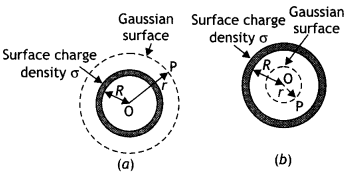
By symmetry, we find that the electric field acts radially outwards and has a
normal component at alt points on the Gaussian sphere. Therefore by definition
of electric flux we have
Φ = E × A, where A is the surface area of the Gaussian sphere therefore
Φ
= E × 4πr² …(1)
But by Gauss’s law
Φ = \(\frac{Q}{\varepsilon_{0}}=\frac{\sigma
A}{\varepsilon_{0}}=\frac{\sigma \times 4 \pi R^{2}}{\varepsilon_{0}}\) …
(2)
from equations (1) and (2) it follows that
E × 4πr² =
\(\frac{Q}{\varepsilon_{0}}\) Or E = \(\frac{1}{4 \pi \varepsilon_{0}}
\frac{Q}{r^{2}}\)
E × 4πr² = \(\frac{\sigma \times 4 \pi R^{2}}{\varepsilon_{0}}\)
Ē = \(\frac{\sigma R^{2}}{\varepsilon_{0} r^{2}}\) … (3)
It follows that the electric field due to a spherical shell outside it is same as that due to a point charge. Therefore for points Lying outside the spherical shell the shell behaves as if the entire charge is concentrated at the centre.
Case 2: at a point inside the spherical shell
In this case, the Gaussian
surface Lies inside the shell. Since no charge is enclosed In this surface
therefore we have
E × 4πr²=q0/ε0 [∵ q=0]
Therefore E = 0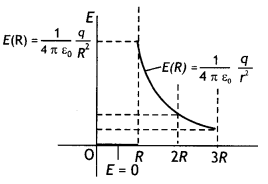
(b) Two identical metallic spheres A and B having charges +4Q. and -10 Q are
kept a certain distance apart. A third identical uncharged sphere C is first
placed in contact with sphere A and then with sphere B. Spheres A and B are then
brought in contact and then separated. Find the charges on the spheres A and B.
Answer:
The initial charge on the sphere A = + 4 Q.
The
initial charge on the sphere B = -10 Q.
Since all the three spheres are identical, i.e. they have the same capacity, therefore when uncharged sphere C is placed in contact with A, the total charge is equally shared between them.
Charge on C after contact with A
= \(\frac{0+4 Q}{2}\) = 2Q
Charge on A after contact with C is 2Q.
When sphere C carrying a charge 2Q
is placed in contact with B, again charges are equally shared between C and B
equally.
Charge on C after it is in contact with B
= \(\frac{2 Q-10 Q}{2}\) =
-4Q
Now when sphere A with a charge of 2Q. is placed in contact with B, with charge -4Q.
Charge are again shared
∴ charge on A or B = \(\frac{2 Q-4 Q}{2}\) =
-Q.
Question 14.
(a) Define electric dipole moment. Is it a scalar or a
vector? Derive the expression for the electric field of a dipole at a point on
the equatorial plane of the dipole.
Answer:
It is defined as the product
of the magnitude of either of the two charges and the distance between them.
For derivation see sol. 9(a) of LA-II.
(b) Draw the equipotential surfaces due to an electric dipole. Locate the
points where the potential due to the dipole is zero.
Answer:
The diagram is as shown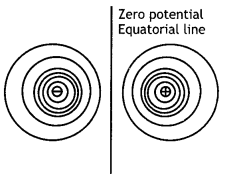
The zero potential points lie on the equatorial line.
Question 15.
(a) Using Gauss’s law obtain expressions for the electric
field (i) inside, and (ii) outside a positively charged spherical shell.
(c)
A Square plane sheet of side 10 cm is inclined at an angle of 30° with the
direction of a uniform electric field of 200 NC“1. Calculate the electric flux
passing through the sheet.
Answer:
(a) Spherical Shell
Consider a spherical shell of radius R. Let q be a charge on the shell. Let us
find the electric field at a point P at a distance r from the center 0 of the
spherical shell.
Case (i): When point P lies inside the spherical shell
From the point, P
draws a Gaussian surface which will be a sphere of radius r.
From the Gauss’s Theorem,
\(\oint_{s} \vec{E} \cdot \vec{d}
S=\frac{0}{\varepsilon_{0}}\) [∵ No charge exists inside the spherical
shell]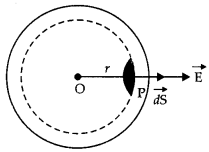
Or
E = 0
i. e. electric field inside the charged spherical shell is
zero.
Case (ii): When point P is lying outside the shell (i.e. r > R)
From
point P, draw a Gaussian surface which will be a spherical shell of radius r.
Let dS be a small area element on the Gaussian surface P.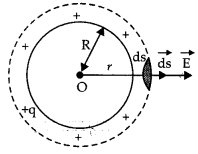
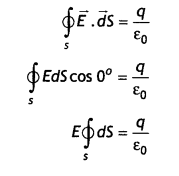
Or
i. e. the electric field outside the spherical shell behaves as if the whole charge is concentrated at the center of the spherical shell.
(b) Show graphically variation of the electric field as a function of the
distance r from the center of the sphere.
Answer:
Variation of electric
field E with distance
The given figure shows the variation of an electric
field with distance from the center of the charged spherical shell.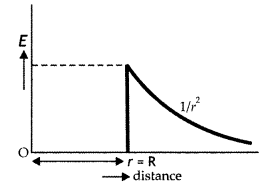
(c) Here E = 200 N/C, S = 0.1 × 0.1 = 0.01 m2
And θ = 90° – 30° =
60°
The electric flux linked with the square sheet
Φ = E S cos 60°
= 200 ×
0.01 × \(\frac { 1 }{ 2 }\) = 1.0 Nm2 C-1
Question 16.
A charge is distributed uniformly over a ring of radius ‘a’.
Obtain an expression for the electric intensity E at a point on the axis of the
ring. Hence show that for points at a large distance from the ring, it behaves
like a point charge.
Answer:
Consider a uniformly
charged ring of radius ‘a’. Let the total charge on the ring be Q, Let us find
the electric field on the axis of the ring at point P distance x from the center
of the ring. Consider a segment of charge dQ as shown in the figure.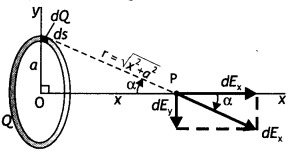
The magnitude of etectñc field at P due to the segment is
dE=k\(\frac{d
Q}{r^{2}}\) …(1)
This field can be resolved into its components: x component dEx =
dE cos α an along the axis of the ring and y component dE perpendicular to the
axis. Since these perpendicular components, due to alt the charge segments, are
equal and opposite, therefore they cancel out each other. From the diagram we
have r = \(\sqrt{x^{2}+a^{2}}\) and cos α = x/r, therefore we have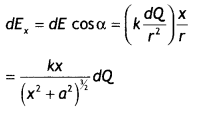 …(2)
…(2)
In this case, all the segments of the ring give the same contribution to the
field at P since they are all equidistant from this point. Thus we can easily
sum over all segments to get the total electric field at point P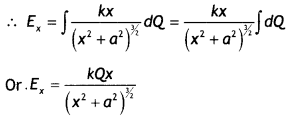
If the point of observation is far away, i.e. x >> a, then E =
\(\frac{1}{4 \pi \varepsilon_{0}} \frac{Q}{x^{2}}\). This is the same as that
for a point charge. Thus at far-off axial points, a charged ring behaves as if a
point charge is situated at the center of the ring.
Question 17.
Two thin concentric and coplanar spherical shells, of radii
‘a’ and ‘b’ (b > a), carry charges, q, and Q respectively. Find the magnitude
of the electric field, at a point distant x, from their common center for
(i)
O < x < a
(ii) a ≤ x < b
(iii) b ≤ x < ∞
Answer:
The diagram is as shown.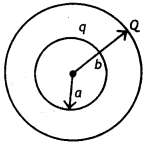
(i) For 0 < x < a
Point Lies inside both the spherical shells.
∴ charge enclosed = 0
Hence, E(x) = 0
(ii) For a < x < b
Point is outside the spherical shell of radius
‘a’ but inside the spherical Shell of radius ‘b’.
Therefore![]()
(iii) For b ≤ x< ∞
The point is outside of both the spherical shells.
The total effect we charge at the center equals (Q + q).
Question 18.
(a) Define electric flux. Is It a scalar or a vector
quantity?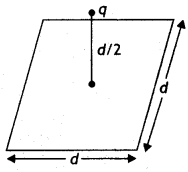
A point charge q is at a distance of d/2 directly above the center of a square
of side d, as shown In the figure. Us. Gauss’s law to obtain the expression for
the electric flux through the square.
Answer:
The electric flux through a
given surface is defined as the dot product of the electric field and area
vector over that surface. It is a scalar quantity.
Constructing a cube of side ‘d’ so that charge ‘q’ gets placed within this
cube (Gaussian surface)
According to Gauss’s law the electric flux
Φ =
\(\frac{q}{\varepsilon_{0}}\)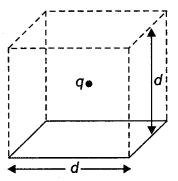
This is the total flux through all the six faces of the cube.
Hence electric flux through the square (one face of the cube)
Φ =
\(\frac{1}{6} \frac{q}{\varepsilon_{0}}\)
(b) If the point charge is now moved to a distance ‘d’ from the center of the
square and the side of the square is doubled, explain how the electric flux will
be affected.
Answer:
If the charge is moved to a
distance ‘d’ and the side of the square is doubled the cube will be constructed
to have a side 2d but the total charge enclosed in it will remain the same.
Hence the total flux through the cube and therefore the flux through the square
will remain the same as before.
Question 19.
(a) Draw a graph to show the variation of E with
perpendicular distance r from the line of charge.
Answer:
The required
graph is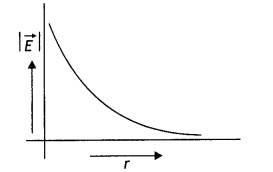
(b) Find the work done in bringing a charge q from perpendicular distance
r1 to r2 (r2 > r1).
Answer:
Work done in moving the charge “q”. through a smaLL
displacement ‘dr’
dW = \(\vec{F}\) . \(\vec{dr}\) =q\(\vec{E}\) .\(\vec{dr}\)
dW = qE dr cos
0 = qEdr
dW= q x \(\frac{\lambda}{2 \pi \varepsilon_{0} r}\) dr
Hence work done in moving the charge from r1 to r2
(r2 > r1)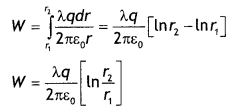
Question 20.
Derive an expression for the torque acting on an electric
dipole of dipole moment \(\vec{p}\) placed in a uniform electric field
\(\vec{E}\). Write the direction along which the torque acts.
OR
Derive an
expression for the electric field at a point on the axis of an electric dipole
of dipole moment \(\vec{p}\). Also, write its expression when the distance r
>> a the length ‘a’ of the dipole.
Answer:
Consider an
electric dipole consisting of charges -q and +q and dipole length d is placed in
a uniform electric field E as shown in the figure.
Let the dipole moment makes an angle θ with the direction of the electric field. The two charges experience force qE each.
These forces are equal, parallel, and opposite. Therefore, the net force
acting on the dipole is
Fn = qE – qE = 0
Thus the net force acting on the dipole is zero.
These two forces constitute a couple. This applies a torque on the dipole
given by
τ = either force × arm of the couple
τ = qE × d sin θ, where d
sin θ is the arm of the couple.
τ = q d Esin θ, where p = qd, dipole
moment
τ = pE sin θ.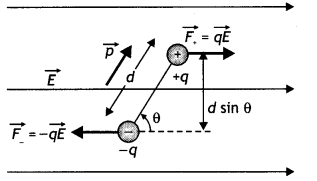
Consider
an electric dipole consisting of -q and +q charges separated by a distance 2a as
shown in the figure. Let P be the point of observation on the axial Line where
the electric field has to be found. Let it be at a distance r from the center O
of the dipole. Let us suppose that the dipole is placed in a vacuum.
Let E and EB be the electric fields at point P due to the charges
at A and B respectively. Therefore,

The two fields at P are in opposite directions. Thus the resultant electric
field at P is given by
E = \(\sqrt{E_{A}^{2}+E_{B}^{2}-2 E_{A} E_{B} \cos
\theta}=\sqrt{\left(E_{B}-E_{A}\right)^{2}}\) = EB –
EA
since θ = 1800 Therefore, the resultant electric field is
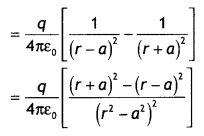
Solving we have
where p = q 2a.
If the dipole is short then r >> a, therefore, ‘a’ is
neglected as compared to r, hence
This field is in the direction of the dipole moment.
Question 21.
(a) Derive the expression for the electric field at a point
on the equatorial line of an electric dipole.
Answer:
Consider an electric dipole consisting of charges -q and +q separated by a
distance 2a as shown in the figure. Let the point of observation P lie on the.
right bisector of the dipole AB at a distance r from its midpoint 0. Let
EA and EB be the electric field intensities at point P due
to charges at A and B, respectively.
The two electric fields have magnitudes
in the direction of AP

in the direction of PB.
The two fields are equal in magnitude but have different directions.
Resolving the two fields EA and EB into their rectangular
components, i.e. perpendicular to and parallel to AB. The components
perpendicular to AB, i.e EA sinG and EB sinG being equal
and opposite cancel out each other while the components parallel to AB, i.e.
EA cos θ and EB cos θ being in the same direction add up
as shown in the figure. Hence the resultant electric field at point P is given
by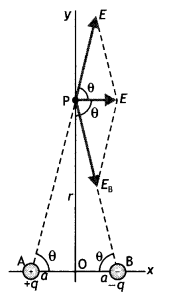
E = EAcosθ + EBcosθ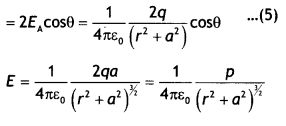
∵
cos θ = \(\frac{a}{\left(r^{2}+a^{2}\right)^{1 / 2}}\) and q 2a = p
For a short dipole r²,>>a² therefore
E = \(\frac{1}{4 \pi
\varepsilon_{0}} \frac{p}{r^{3}}\)
(b) Discuss the orientation of the dipole in (a) stable, (b) unstable
equilibrium in a uniform electric field.
Answer:
For
stable equilibrium \(\vec{P}\) is along \(\vec{E}\)
θ = 0°, τ = PE sin 0°,
Torque alligns the dipole in the direction of field
For unstable equilibrium \(\vec{P}\) is antiparallel to \(\vec{E}\)
∵ θ =
180°, τ = PE sin 180° = 0, Torque alligns the dipole in a direction opposite to
\(\vec{E}\).
Question 22.
(a) An electric dipole of dipole moment \(\vec{p}\) consists
of point charges +q and -q separated by a distance 2a apart. Deduce the
expression for the electric field due to the dipole at a distance x from the
center of the dipole on its axial line in terms of the dipole moment. Hence show
that in
the limit r >> a, \(\vec{E}\) → \(\frac{2 \vec{p}}{4 \pi
\varepsilon_{0} r^{3}}\)
Answer:
Consider an electric dipole consisting of charges -q and +q and dipole length d is placed in a uniform electric field E as shown in the figure.
Let the dipole moment makes an angle θ with the direction of the electric field. The two charges experience force qE each.
These forces are equal, parallel, and opposite. Therefore, the net force
acting on the dipole is
Fn = qE – qE = 0
Thus the net force acting on the dipole is zero.
These two forces constitute a couple. This applies a torque on the dipole
given by
τ = either force × arm of the couple
τ = qE × d sin θ, where d
sin θ is the arm of the couple.
τ = q d Esin θ, where p = qd, dipole
moment
τ = pE sin θ.
Consider
an electric dipole consisting of -q and +q charges separated by a distance 2a as
shown in the figure. Let P be the point of observation on the axial Line where
the electric field has to be found. Let it be at a distance r from the center O
of the dipole. Let us suppose that the dipole is placed in a vacuum.
Let E and EB be the electric fields at point P due to the charges at A and B
respectively. Therefore,

The two fields at P are in opposite directions. Thus the resultant electric
field at P is given by
E = \(\sqrt{E_{A}^{2}+E_{B}^{2}-2 E_{A} E_{B} \cos
\theta}=\sqrt{\left(E_{B}-E_{A}\right)^{2}}\) = EB –
EA
since θ = 1800 Therefore, the resultant electric field is

Solving we have
where p = q 2a.
If the dipole is short then r >> a, therefore, ‘a’ is
neglected as compared to r, hence
This field is in the direction of the dipole moment.
(b) Given the electric field in the region E = 2xî, find the net electric
flux through the cube and the charge enclosed by it. 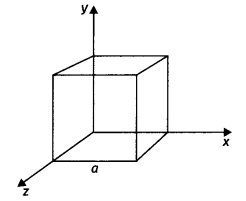
Answer:
Since the electric field has only an x component, for faces
perpendicular to the x-direction, the angle between E and ΔS is ± π/2.
Therefore, the flux Φ = E.ΔS is separately zero for each face of the cube except the two faces along the X-axis.
Now the magnitude of the electric field at the left face is
EL=
0 (x = 0 at the left face)
The magnitude of the electric field at the right face is
ER =
2x = 2a (x = a at the right face)
The corresponding fluxes are
ΦL = EL.ΔS = ΔS
(\(\vec{E}_{L} \cdot \hat{n}_{\mathrm{L}}\)) = ELΔS COS θ
= –
EL ΔS = 0, since θ =180°
ΦR = ER.ΔS = ERΔS cos θ = E ΔS = (2a)a2, since θ = 0°
Net flux through the cube
Φ = -ΦR + ΦL =
2a3 -0 = 2a3
We can use Gauss’s law to find the total charge q inside the cube.
We have
Φ = q/ε0 or q = Φε0. Therefore, q = 2a3 × 8.854
× 10-12C
Question 23.
(a) Derive an expression for the electric field at any point
on the equatorial line of an electric dipole.
Answer:
Consider an electric
dipole consisting of charges -q and +q separated by a distance 2a as shown in
the figure. Let the point of observation P lie on the. right bisector of the
dipole AB at a distance r from its midpoint 0. Let EA and EB be the electric
field intensities at point P due to charges at A and B, respectively.
The two electric fields have magnitudes
in the direction of AP

in the direction of PB.
The two fields are equal in magnitude but have different directions.
Resolving the two fields EA and EB into their rectangular
components, i.e. perpendicular to and parallel to AB. The components
perpendicular to AB, i.e EA sinG and EB sinG being equal
and opposite cancel out each other while the components parallel to AB, i.e.
EA COS θ and EB cos θ being in the same direction add up
as shown in the figure. Hence the resultant electric field at point P is given
by
E = EA cos θ + EB cos θ
∵
cos θ = \(\frac{a}{\left(r^{2}+a^{2}\right)^{1 / 2}}\) and q 2a = p
For a short dipole r²,>>a² therefore
E = \(\frac{1}{4 \pi
\varepsilon_{0}} \frac{p}{r^{3}}\)
(b) Two identical point charges, q each, are kept 2 m apart in the air. A
third point charge Q of unknown magnitude and sign is placed on the line joining
the charges such that the system remains in equilibrium. Find the position and
nature of Q.
Answer:
The third charge Q. wilt is in
equilibrium if it experiences zero net force. Let it be placed at a distance x
meter from the charge q.

Solving for x, we have x= 1 m
For the equilibrium of charges “q”, the nature of charge Q must be opposite to the nature of charge q and should be placed at the center of two charges.
Question 24.
(a) Define electric flux. Write its S.I. unit.
Answer:
It is defined as the total number of electric field lines crossing a given area.
The electric flux can be found by multiplying the component of the electric
field in the direction of the area vector (or perpendicular to the area) with
the area of the closed surface. It is measured in
Nm2C--1.
(b) A small metal sphere carrying charge +Q is located at the center of a
spherical cavity inside a large uncharged metallic spherical shell as shown in
the figure. Use Gauss’s law to find the expressions for the electric field at
points P1 and P2.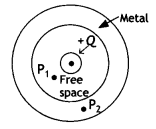
Answer:
For point P, using Gauss law we have
Since E and dA are in the same direction therefore we have E = \(\frac{Q}{\varepsilon_{0} A}\)
Point P2 lies inside the metal, therefore the Gaussian surface drawn at P2 does not include a charge, hence the electric field at P2 is zero.
(c) Draw the pattern of electric field lines in this arrangement.
Answer:
The electric field lines are as shown.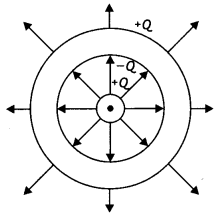
Question 25.
(a) Deduce the expression for the torque acting on a dipole
of dipole moment \(\vec{P}\) in the presence of a uniform electric field
\(\vec{E}\)
Answer:
Consider an electric dipole consisting of charges -q and +q and dipole length d is placed in a uniform electric field E as shown in the figure.
Let the dipole moment makes an angle θ with the direction of the electric field. The two charges experience force qE each.
These forces are equal, parallel, and opposite. Therefore, the net force
acting on the dipole is
Fn = qE – qE = 0
Thus the net force acting on the dipole is zero.
These two forces constitute a couple. This applies a torque on the dipole
given by
τ = either force × arm of the couple
τ = qE × d sin θ, where d
sin θ is the arm of the couple.
τ = q d Esin θ, where p = qd, dipole
moment
τ = pE sin θ.
Consider
an electric dipole consisting of -q and +q charges separated by a distance 2a as
shown in the figure. Let P be the point of observation on the axial Line where
the electric field has to be found. Let it be at a distance r from the center O
of the dipole. Let us suppose that the dipole is placed in a vacuum.
Let E and EB be the electric fields at point P due to the charges at A and B
respectively. Therefore,

The two fields at P are in opposite directions. Thus the resultant electric
field at P is given by
E = \(\sqrt{E_{A}^{2}+E_{B}^{2}-2 E_{A} E_{B} \cos
\theta}=\sqrt{\left(E_{B}-E_{A}\right)^{2}}\) = EB –
EA
since θ = 180° Therefore, the resultant electric field is

Solving we have
where p = q 2a.
If the dipole is short then r >> a, therefore, ‘a’ is
neglected as compared to r, hence
This field is in the direction of the dipole moment.
(b) Consider two hollow concentric spheres S1 and S2
and enclosing charges 2Q and 4Q. respectively as shown in the figure, (i) Find
out the ratio of the electric flux through them, (ii) How will the electric flux
through the sphere S1 change if a medium of dielectric constant ‘er’
is introduced in the space inside S1 in place of air? Deduce the necessary
expression. 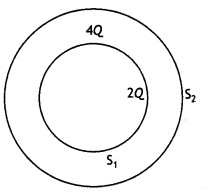
Answer:
Φ1 = \(\frac{2 Q}{\varepsilon_{0}}\) and Φ2 = \(\frac{2
Q+4 Q}{\varepsilon_{0}}=\frac{6 Q}{\varepsilon_{0}}\)
Hence ratio 
When a dielectric of dielectric constant εr is introduced then we
have
Φ1 = \(\frac{2 Q}{\varepsilon}=\frac{2 Q}{\varepsilon_{r}
\varepsilon_{0}}\)
Question 26.
(a) Using Gauss’ law, derive an expression for the electric
field intensity at any point outside a uniformly charged thin spherical shell of
radius R and charge density a C/m2. Draw the field lines when the charge density
of the sphere is
(i) positive,
(ii) negative.
(b) A uniformly charged
conducting sphere of 2.5 m in diameter has a surface charge density of 100
µC/m2. Calculate the
(i) charge on the sphere
(ii) total
electric flux passing through the sphere (Delhi 2008)
Answer:
(a) (i) To
find out electric field at a point outside a spherical charged shell we imagine
a symmetrical Gaussian surface in such a way that the point lies on it.
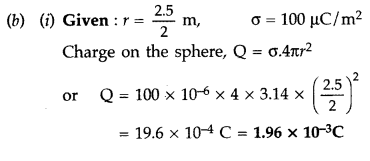

Question 27.
(a) Define electric flux. Write its SI units.
(b) The
electric field components due to a charge inside the cube of side 0.1 m are as
shown :
Ex = ax, where α = 500 N/C-m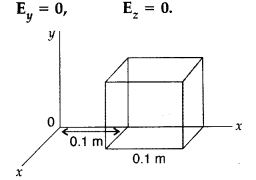
Calculate
(i) the flux through the cube, and
(ii) the
charge inside the cube. (All India 2008)
Answer:
(a) Electric flux through
a surface represents the total number of electric lines of force crossing the
surface.
∴ S.I. unit is Nm2 C-1.
(b) (i) Flux
through R.H.S. of the cube is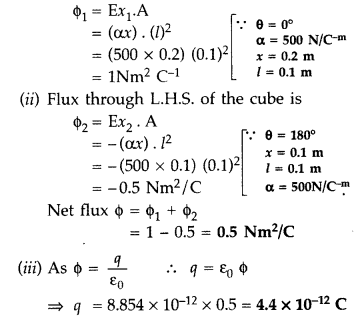
Question 28.
(a) Define electric flux. Write its S.I. units.
(b) Using
Gauss’s law, prove that the electric field at a point due to a uniformly charged
infinite plane sheet is independent of the distance from it.
(c) How is the
field directed if
(i) the sheet is positively charged,
(ii) negatively
charged? (Delhi 2012)
Answer:
(a) Electric flux: The electric flux through
a given area held inside an electric field is the measure of the total number of
electric lines of force passing normally through that area.
(b) Consider a thin, infinite plane sheet of charge with uniform surface charge
density 0. We wish to calculate its electric field at a point P at distance r
from it.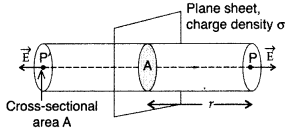
By symmetry, electric field E points outwards normal to the
sheet. Also, it must have same magnitude and opposite direction at two points P
anel F equidistant from the sheet and on opposite sides. We choose cylindrical
Gaussian surface of cross¬sectional area A and length 2r with its axis
perpendicular to the sheet.
As the lines of force are parallel to the curved surface of the cylinder, the
flux through the curved surface is zero. The flux through the plane-end faces of
the cylinder is :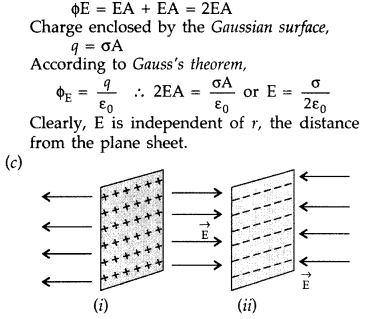
(i) For positively charged sheet ➝ away from the sheet
(ii)For negatively
charged sheet ➝towards the sheet
Question 29.
(a) Define electric flux. Write its S.I. unit.
(b) A small
metal sphere carrying charge +Q is located at the centre of a spherical cavity
inside a large uncharged metallic spherical shell as shown in the figure the
expressions for the electric field at points P1 and
P2.
(c) Draw the pattern of electric field lines in this
arrangement. (Comptt. All India 2012)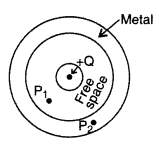
Answer:
(a) Electric flux: The electric flux through a
given area held inside an electric field is the measure of the total number of
electric lines of force passing normally through that area.
(b) Consider a thin, infinite plane sheet of charge with uniform surface charge
density 0. We wish to calculate its electric field at a point P at distance r
from it.
By symmetry, electric field E points outwards normal to the
sheet. Also, it must have same magnitude and opposite direction at two points P
anel F equidistant from the sheet and on opposite sides. We choose cylindrical
Gaussian surface of cross-sectional area A and length 2r with its axis
perpendicular to the sheet.
As the lines of force are parallel to the curved surface of the cylinder, the
flux through the curved surface is zero. The flux through the plane-end faces of
the cylinder is :
(i) For positively charged sheet ➝ away from the sheet
(ii)For negatively
charged sheet ➝towards the sheet
(b) Calculation of electric field at point Pt:
Net charge enclosed by the
Gaussian surface is +Q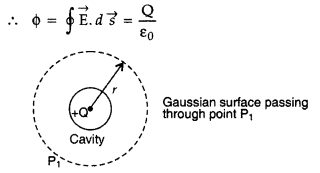
As electric field of positive charge is radially outwards, it is parallel to the
area vector on the surface chosen.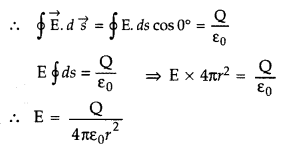
As point P2 lies inside the metal, therefore
electric field at point P2 is zero.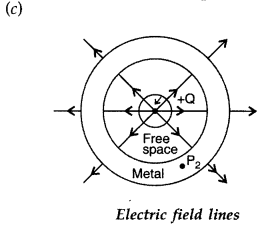
Question 30.
Define electric dipole moment. Is it a scalar or a vector?
Derive the expression for the electric field of a dipole at a point on the
equatorial
plane of the dipole. (All India 2013)
Answer:
Electric
dipole moment: It is the product of the magnitude of either charge and distance
between them.
It is a vector quantity whose direction is from negative to
positive charge.
Electric field intensity at P due to +q charge is
Electric field intensity at P due to -q charge is,

Question 31.
Using Gauss’ law deduce the expression for the electric field
due to a uniformly charged spherical conducting shell of radius R at a point
(i) outside and
(ii) inside the shell.
Plot a graph showing variation of
electric field as a function of r > R and r < R (r being the distance from
the centre of the shell) (All India)
Answer:
(i) Field Outside Shell :
Consider a thin spherical shell of radius R with centre O. Let charge +q be
distributed uniformly over the surface of shell. To calculate electric field
intensity at P where OP = r, imagine a sphere S, with centre at O and radius r.
The surface of sphere is Gaussian surface over at every point. Electric field is
same and directed radially outwards.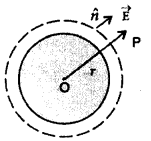
Applying Gauss’ theorem
\(\overrightarrow { r } \) is distance of point P from centre where E is
calculated]
(ii) Inside Shell: As we know charge is located on its
surface,![]()
(iii) at r < R \(\overrightarrow { E } \) is zero and
r = R, E is maximum at r > R, E is decreasing at E ∝ \(\frac { 1 }{ { r
}^{ 2 } } \)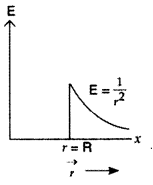
Question 32.
Using Gauss’s law, derive the expression for the electric
field at a point
(i) outside and
(ii) inside a uniformly charged thin
spherical shell. Draw a graph showing electric field E as a function of distance
from the centre.
Answer:
Electric field due to a
uniformly charged spherical shell:
Suppose a thin spherical shell of radius R
and centre O
Let the charge + q be distributed over the surface of sphere
Electric field intensity \(\overrightarrow { E } \) is same at every point on
the surface of sphere directed directly outwards
Let a point P be outside the
shell with radius vector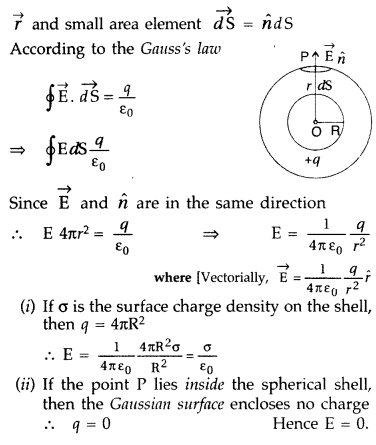
Question ![]() .
.
(a) Deduce the expression for the torque acting on a dipole
of dipole moment \(\overrightarrow { p } \) in the presence of a uniform
electric field E.
(b) Consider two hollow concentric spheres, S1
and S2, enclosing charges 2Q and 4Q respectively as shown in the
figure.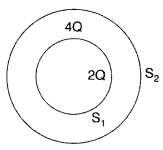
(i) Find out the ratio of the electric flux through them.
(ii) How will the electric flux through the sphere S1 change if a
medium of dielectric constant ‘εr‘ is introduced in the space inside
S1, in place of air? Deduce the necessary expression. (All India
2014)
Answer:
(a) Torque on electric dipole. Consider an electric dipole
consisting of two equal and opposite point charges separated by a small distance
2a having dipole moment
So net force on the dipole is zero
Since ![]() is uniform, hence the dipole does not undergo any translatory
motion.
is uniform, hence the dipole does not undergo any translatory
motion.
These forces being equal, unlike and parallel, from a couple, which rotates
the dipole in clock-wise direction
∴ Magnitude of torque = Force × arm of
couple
[The direction of \(\vec{\tau} \) is given by right hand screw rule and is
normal to \(\vec{p} \) ] and \(\vec{E} \)
Special cases
(i) when θ =
0 then τ = PE sin θ = 0
∴ Torque is zero and the dipole is in stable
equilibrium
(ii) When θ = 90 then τ = PE sin 90 = PE
∴ The Torque is
maximum
(b) Ratio of flux

∴ Electric flux through the sphere S1 decreases with the introduction
of dielectric inside it.
Question 33.
(a) An electric dipole of dipole moment \(\overrightarrow { p
} \) consists of point charges + q and – q separated by a distance 2a apart.
Deduce the expression for the electric field \(\overrightarrow { E } \) due to
the dipole at a distance x from the centre of the dipole on its axial line in
terms of the dipole moment \(\overrightarrow { p } \)?. Hence show that in the
limit x >> a, \(\overrightarrow { E } \) —>2\(\overrightarrow { p } \)
(4πε0x3).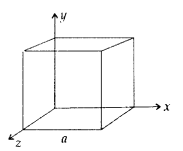 (Delhi 2015)
(Delhi 2015)
Answer:
(a) Expression for magnetic field due
to dipole on its axial lane: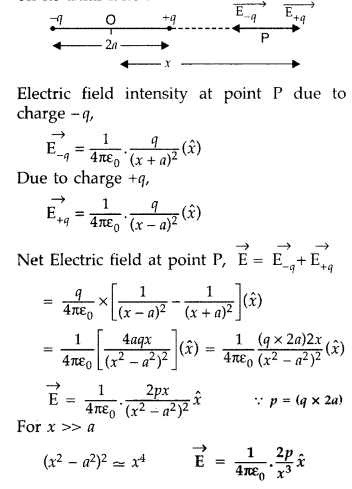
(b)Only the faces perpendicular to the direction of x-axis, contribute to the
Electric flux. The remaining faces of the cube given zero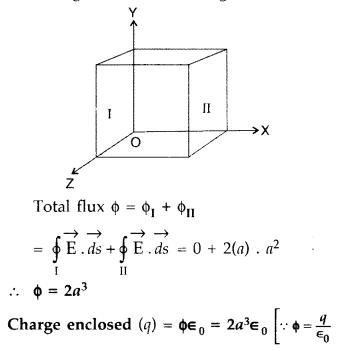
Question 34.
(a) Define electric flux. Write its S.I. unit. “Gauss’s law
in electrostatics is true for any closed surface, no matter what its shape or
size is”. Justify this statement with the help of a suitable example.
(b) Use
Gauss’s law to prove that the electric field inside a uniformly charged
spherical shell is zero. (All India)
(a) Electric flux. The electric lines of
force passing through that area, when held normally to the lines of force.
Answer:
Electric flux. The electric lines of force passing through that area,
when held normally to the lines of force.![]()
S.I. units: Vm, Nm2C-1
Gauss’s Law
states that the electric flux through a closed surface is given by![]()
The law implies that the total electric flux through a closed
surface depends on the quantity of total charge enclosed by the surface, and
does not depend on its shape and size.
For example, net charge enclosed by the electric dipole (q, -q) is zero,
hence the total elec¬tric flux enclosed by a surface containing electric dipole
is zero.
(b) Electrical field inside a uniformly charged spherical shell. Let
us consider a point ‘P’ inside the shell. The Gaussian surface is a sphere
through P centred at O.
The flux through the Gaussian surface is E × 4πr2.
However, in this case, the Gaussian surface encloses no charge. Gauss’s law
then gives
E × 4πr2 = 0
or E = 0
(r < R)
that is, the
field due to a uniformly charged thin shell is zero at all points inside the
shell.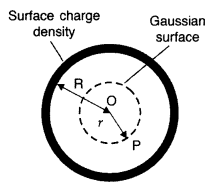
Question 35.
(a) Derive the expression for the energy stored in a parallel
plate capacitor. Hence obtain the expression for the energy density of the
electric field.
(b) A fully charged parallel plate capacitor is connected
across an uncharged identical capacitor. Show that the energy stored in the
combination is less than that stored initially in the single capacitor. (All
India 2015)
Answer:
(a) (i) Energy of a parallel plate capacitor. Consider
a capacitor of capacitance C. Initial charge on plates is zero. Initial
potential difference between the capacitor plates is zero. Let a charge Q be
given to it in small steps. When charge is given to capacitor, the potential
difference between its plates increases. Let at any instant when charge on
capacitor be q, the potential difference between its plates be,![]()
Now work done in giving an additional infinitesimal charge dq
to capacitor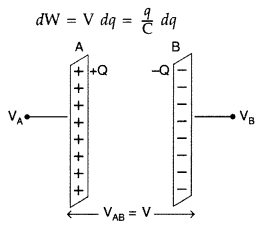
The total work done in giving charge from 0 to Q will be
equal to the sum of all such infinitesimal works, which may be obtained by
integration. Therefore total work

If V is the final potential difference between capacitor
plates, then Q = CV![]()
This work is stored as electrostatic potential energy of
capacitor i.e., Electriostatic potential energy,![]()
(ii) Expression for Energy Density.
Consider a parallel
plate capacitor consisting of plates, each of area A, separated by a distance d.
If space between the plates is filled with a medium of dielectric constant K,
then
Capacitence of Capacitor,![]()
If σ is the surface charge density of plates, then electric
field strength between the plates.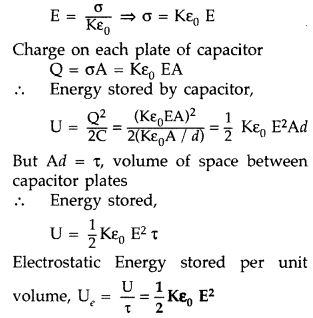
This is the expression for electrostatic energy density in medium of dielectric
constan K. In air of free space (K = 1), therefore energy density,![]()
(b) The energy of the capacitor when fully charged is![]()
When this charged capacitor is connected to an identical capacitor C, then the
charge will be distributed equally, \(\frac { q }{ 2 } \) on each of the
capacitors, then
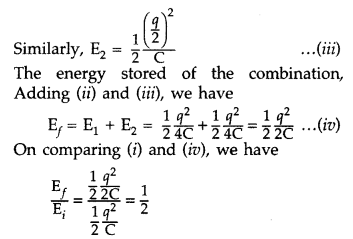
Hence, the total energy stored is half of that stored initially in one capacitor
which means the energy stored in combination is less than that stored initially
in the single capacitor.
Question 36.
(i) Use Gauss’s law to find the electric field due to a
uniformly charged infinite plane sheet. What is the direction of field for
positive and negative charge densities?
(ii) Find the ratio of the potential
differences that must be applied across the parallel and series combination of
two capacitors Cj and C2 with their capacitances in the ratio 1 : 2 so that the
energy stored in the two cases becomes the same. (All India 2016)
Answer:
(i)
(a) Electric flux: The electric flux through a given area held inside an
electric field is the measure of the total number of electric lines of force
passing normally through that area.
(b) Consider a thin, infinite plane sheet of charge with uniform surface charge
density 0. We wish to calculate its electric field at a point P at distance r
from it.
By symmetry, electric field E points outwards normal to the
sheet. Also, it must have same magnitude and opposite direction at two points P
anel F equidistant from the sheet and on opposite sides. We choose cylindrical
Gaussian surface of cross¬sectional area A and length 2r with its axis
perpendicular to the sheet.
As the lines of force are parallel to the curved surface of the cylinder, the
flux through the curved surface is zero. The flux through the plane-end faces of
the cylinder is :
(i) For positively charged sheet ➝ away from the sheet
(ii)For negatively
charged sheet ➝towards the sheet
(b) and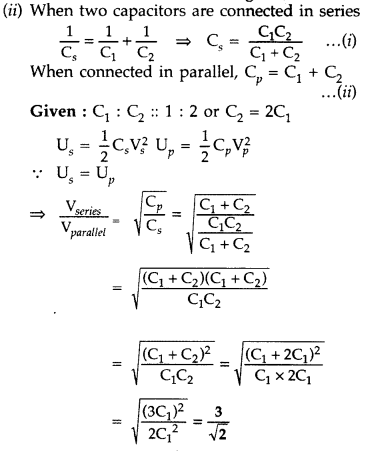
Question 37.
(a) Derive an expression for the electric field E due to a
dipole of length ‘2a’ at a point distant r from the centre of the dipole on the
axial line. (b) Draw a graph of E versus r for r >> a.
(c) If this
dipole were kept in a uniform external electric field diagrammatically represent
the position of the dipole in stable and unstable equilibrium and write the
expressions for the torque acting on the dipole in both the cases. (Outside
Delhi 2017)
Answer:
(a) Expression for magnetic field due to dipole on its
axial lane:
(b)Only the faces perpendicular to the direction of x-axis, contribute to the
Electric flux. The remaining faces of the cube given zero
(b) Graph between E Vs r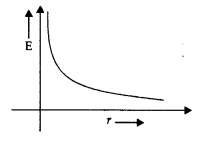
(i) Diagrammatic representation
(ii) Torque acting on
these cases
(i) In stable equilibrium, torque is zero (θ = 0)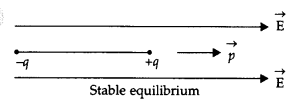
(ii) In unstable equilibrium also, torque is zero (θ =
180°)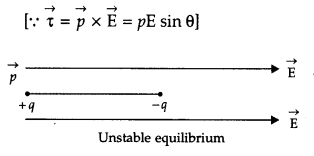
Question 38.
(a) Use Gauss’s theorem to find the electronic field due to a
uniformly charged infinitely large plane thin sheet with surface charge density
a.
(b) An infinitely large thin plane sheet has a uniform surface charge
density +a. Obtain the expression for the amount of work done in bringing a
point charge q from infinity to a point, distant r, in front of the charged
plane sheet. (Outside Delhi 2017)
Answer:
(a) Electric flux: The electric
flux through a given area held inside an electric field is the measure of the
total number of electric lines of force passing normally through that
area.
(b) Consider a thin, infinite plane sheet of charge with uniform surface charge
density 0. We wish to calculate its electric field at a point P at distance r
from it.
By symmetry, electric field E points outwards normal to the
sheet. Also, it must have same magnitude and opposite direction at two points P
anel F equidistant from the sheet and on opposite sides. We choose cylindrical
Gaussian surface of cross¬sectional area A and length 2r with its axis
perpendicular to the sheet.
As the lines of force are parallel to the curved surface of the cylinder, the
flux through the curved surface is zero. The flux through the plane-end faces of
the cylinder is :
(i) For positively charged sheet ➝ away from the sheet
(ii)For negatively
charged sheet ➝towards the sheet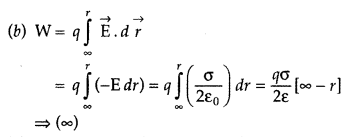
Question 39.
(a) State Gauss’ law. Using this law, obtain the expression
for the electric field due to an infinitely long straight conductor of linear
charge density X.
(b) A wire AB of length L has linear charge density λ = kx,
where x is measured from the end A of the wire. This wire is enclosed by a
Gaussian hollow surface. Find the expression for the electric flux through this
surface.
(Comptt. Outside Delhi 2017)
Answer:
(a)
Gauss’s law in
electrostatics : It states that “the total electric flux over the surface S in
vaccum is \(\frac{1}{\varepsilon_{0}}\) times the total charge (q).”
Electric
field due to an infinitely long straight wire : Consider an infinitely long
straight line charge having linear charge density X to determine its electric
field at distance r. Consider a cylindrical Gaussian surface of radius r and
length l coaxial with the charge. By symmetry, the electric field E has same
magnitude at each point of the curved surface Sj and is directed radially
outward.
Total flux through the cylindrical surface,
(b) Given : Length of wire = L, Charge density (λ) = kx, ϕ = ?
We
know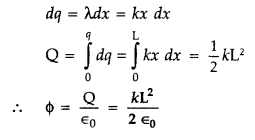
Question 40.
Two point charges 4 (J.C and +1 pC are separated by a
distance of 2 m in air. Find the point on the line-joining charges at which the
net electric field of the system is zero. (Comptt. Outside Delhi 2017)
Answer:
q1 = 4 µC, q2 = 1 µC, r = 2 m
At this point,
the net electric field of the system is zero.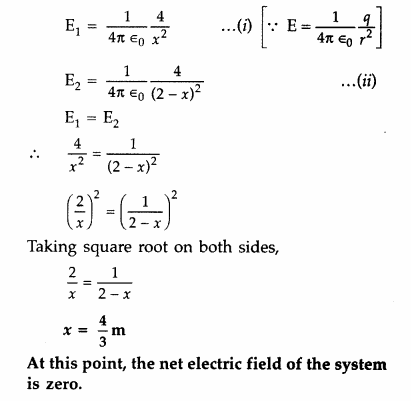
Question 41.
(a) Use Gauss’s theorem to find the electric field due to a
uniformly charged infinitely large plane thin sheet with surface charge density
σ.
Answer:
It states, “The net electric flux through any Gaussian surface
is equal to \(\frac{1}{\varepsilon_{0}}\) times the net electric charge enclosed
by the surface.
Mathematically, Φ =\( \phi \vec{E} \cdot d \vec{A}=\frac{q_{i n}}{\varepsilon_{0}}\)
Consider an infinite plane sheet of charge. Let a be the uniform surface charge density, i.e. the charge per unit surface area. From symmetry, we find that the electric field must be perpendicular to the plane of the sheet and that the direction of E on one side of the plane must be opposite to its direction on the other side as shown in the figure below. In such a case let us choose a Gaussian surface in the form of a cylinder with its axis perpendicular to the sheet of charge, with ends of area A.
The charged sheet passes through the middle of the cylinder’s length so that the cylinder’s ends are equidistant from the sheet. The electric field has a normal component at each end of the cylinder and no normal component along the curved surface of the cylinder. As a result, the electric flux is linked with only the ends and not the curved surface.

Therefore by the definition of eLectric flux, the flux Linked with the
Gaussian surface is given by
Φ = \(\oint_{A} \vec{E} \cdot \vec{\Delta}
A\)
Φ = EA + EA = 2EA … (1)
But by Gauss’s Law
Φ = \(\frac{q}{\varepsilon_{0}}=\frac{\sigma A}{\varepsilon_{0}}\) [∵ q = σA] … (2)
From equations (1) and (2), we have
2EA = \(\frac{\sigma A}{\varepsilon_{0}}\) … (3)
E = \(\frac{\sigma}{2 \varepsilon_{0}}\) …. (4)
This gives the electric field due to an infinite plane sheet of charge which is independent of the distance from the sheet.
(b) An infinitely large thin plane sheet has a uniform surface charge density
+σ. Obtain the expression for the amount of work done in bringing a point charge
q from infinity to a point, distant r, in front of the charged plane sheet.
Answer:
Work done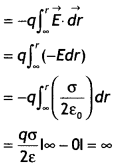
Numerical Problems:
Formulae for solving numerical problems
- q = ±ne
- F = \(\frac{1}{4 \pi \varepsilon_{0}} \frac{q_{1} q_{2}}{r^{2}}\)
- Fmed = \(\frac{1}{4 \pi \varepsilon_{0} K} \frac{q_{1} q_{2}}{r^{2}}\) where K is dielectric constant.

- E = \(\frac{1}{4 \pi \varepsilon_{0}} \frac{2 p}{r^{3}}\) for an electric dipole on its axial line.
- E = \(\frac{1}{4 \pi \varepsilon_{0}} \frac{p}{r^{3}}\) for an electric dipole on its equitorial line.
- Torque on an electric dipole in a uniform electric field, τ = PE sin θ.
- U = -pE cos θ, the potential energy of an electric dipole.
- Φ = \(\oint \vec{E} \cdot d \vec{A}=\frac{q_{\text {in }}}{\varepsilon_{0}}\)
- E = \(\frac{\sigma}{2 \varepsilon_{0}}\) , electric field due to an infinite plane sheet of charge.
Question 1.
An electric dipole of length 2 cm is placed with its axis
making an angle of 60° to a uniform electric field of 105 NC-1. If it
experiences a torque of 8\(\sqrt{3}\) Nm, calculate the (i) magnitude of the
charge on the dipole and (ii) potential energy of the dipole.
Answer:
(i)
Using
q = τ / L E sin Φ
we have
q = 8N\(\sqrt{3}\) × 2 / 2 × 10-2 × 105 ×
\(\sqrt{3}\) = 8 × 10-3 C
(ii) Using U = -pE cos θ, we have
U = – 8 × 10-3 × 0.02 ×
105 × 0.5 = – 8 J
Question 2.
A charge of 17.7 × 10-4 C is distributed uniformly
over a large sheet of area 200 m2. Calculate the electric field
intensity at a distance of 20 cm from it in the air.
Answer:
Given q =
17.7 × 10-4C, A = 200 m2, r = 20cm = 0.2 m
Using the relation
Question 3.
Two fixed point charges +4e and +e units are separated by a
distance ‘a’. Where should the third point charge be placed for it to be in
equilibrium?
Answer:
The third charge will be in equilibrium if it
experiences zero net force. Let it be placed at a distance x from the charge
4e.

4(a – x)2 = x2 solving for x we have
2 (a – x) = x
or x = a/3
Question 4.
An electric field along the x-axis is given by \(\vec{E}\) =
100 îN/C for x > 0 and \(\vec{E}\) = -100 îN/C for x < 0. A right circular
cylinder of length 20 cm and radius 5 cm lies parallel to the x-axis with its
centre at the origin and one face at x = +10 cm, the other face at x = -10 cm.
Calculate the net outward flux through the cylinder. 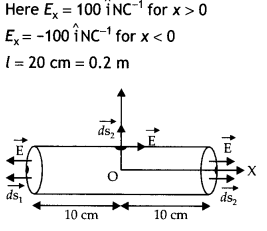
r = 5 cm = 0.05 m
Φ = ?
Net outward flux through the cylinder
Φ = Φ1 + Φ2 +
Φ3
= \(\vec{E} \cdot \overrightarrow{d s}_{1}+\vec{E} \cdot
\overrightarrow{d s}_{2}+\vec{E} \cdot \overrightarrow{d s}_{3}\)
= Eds1 cos 180° + Eds2 cos 90° + Eds3 cos 0°
= –
Eds1 + Eds2 (0) + Eds cos 0°
= – (-100) ds + 100 ds
= (100 +100) ds
= 200 × πr² = 200 × 3.14 × (0.05)²
= 1.57 Nm2
C-1
Question 5.
A hollow cylindrical box of length 1m and area of
cross-section 25 cm2 is placed in a three-dimensional coordinate
system as shown in the figure. The electric field
in the region is given by
\(\vec{E}\) = 50x î, where E is in NC-1 and x is in meters. Find
(i) Net flux through the cylinder.
Answer:
We can see from the figure
that on the left face E and dS are antiparallel. Therefore, the flux is
ΦL =
\(\vec{E}\).\(\vec{dS}\) = E dS cos 180°
= -50 × 1 × 25 × 10-4 =
-0.125 N m2 C-1
On the right face, E and dS are parallel and therefore
ΦR =
\(\vec{E}\).\(\vec{ds}\) = EdS cos 0°
= 50 × 2 × 25 × 10-4 = 0.250
N m2 C-1
Therefore net flux is – 0.125 + 0.250 = + 0.125 N m2 C-1
(ii) Charge enclosed by the cylinder. (CBSE Delhi 2013)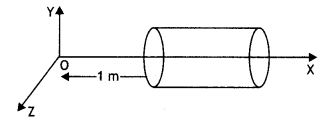
Answer:
q = Φε0 = 0.125 × 8.854 × 10-12 = 1.1 ×
10-12C
Question 6.
(i) Define electric flux. Write its SI units,
Answer:
(i) It is defined as the number of electric field lines crossing a unit area
perpendicular to the given area. It is measured in N m2
C-1
(ii) Consider a uniform electric field \(\vec{E}\) = 5 × 103î
NC-1. Calculate the flux of this field through a square surface of
area 12 cm2 when
(a) its plane is parallel to the Y – Z plane,
and
(b) the normal to its plane makes a 60° angle with the x-axis. (CBSE
Delhi 2013C)
Answer:
Given \(\vec{E}\) = 5 × 103î N
C-1, A = 12 cm2 = 12 × 10-4 m2
(a) Here \(\vec{E}\) = 5 × 103î N C-1
Area of square = 12 ×
10-4 m2
The plane of surface area being parallel to YZ plane, hence
A = 12 ×
10-4 î m2
Electric flux of the field
Φ = \(\vec{E}\) \(\vec{A}\) = (5 ×
103 î). (12 × 10-4î) = 6 N C-1
m2
(b) When normal to the plane of surface area makes an angle of
60° with the X-axis, the flux is given by
Φ = EA cos 0 = 5 × 103 ×
12 × 10-4 × 0.5
= 3 NC-1 m2